The following slides were prepared for a novice diver training course under the Canadian Diving Program leading to CMAS certification. Feel free to browse through them. The presentation is copyright protected so don’t copy the slides unless you first contact me for permission via the comment form at the end of the presentation or via the contact form.
 This photograph was taken off the island of Nassau in the Bahamas during the filming of a documentary on sharks. The shark in this picture is the Caribbean Reef Shark, Carcharhinus perezi. Sharks are large predators so can be dangerous. For the novice diver, it is best to dive with a professional at one of the guided dive sites – and do as you are told!
This photograph was taken off the island of Nassau in the Bahamas during the filming of a documentary on sharks. The shark in this picture is the Caribbean Reef Shark, Carcharhinus perezi. Sharks are large predators so can be dangerous. For the novice diver, it is best to dive with a professional at one of the guided dive sites – and do as you are told!
 This PowerPoint presentation was prepared by Dr. Alan Emery, President, KIVU Nature Inc. (www.kivu.com). Alan began diving in the mid-1950s (before retail sale of SCUBA gear was available) using home-made equipment derived from airplane parts and steam fittings. Fortunately he survived that stupidity and does not advise modern beginners taking unnecessary chances. His background and research is in marine biology and he has worked in many of the world’s oceans from the high Arctic to the tropics.
This PowerPoint presentation was prepared by Dr. Alan Emery, President, KIVU Nature Inc. (www.kivu.com). Alan began diving in the mid-1950s (before retail sale of SCUBA gear was available) using home-made equipment derived from airplane parts and steam fittings. Fortunately he survived that stupidity and does not advise modern beginners taking unnecessary chances. His background and research is in marine biology and he has worked in many of the world’s oceans from the high Arctic to the tropics.
A word on the photographs and diagrams. Most of the photographic material is from my own collection. Some are from the National Oceanographic and Atmospheric Administration as well as several other US government agencies. It is their policy to have all the material in the public domain, so the images are available for any type of use. The remaining photographs are from photographers who have made their work available under the Creative Commons Copyright Licenses. All the ones used here in that category are freely available for essentially any use except commercial sale or the appearance of advertising or endorsing a product and are used herein that capacity.
This presentation in its entirety is copyright © 2013 KIVU Nature Inc. All rights are reserved, no pictures or text may be removed from the PowerPoint presentation without written permission from KIVU Nature Inc. Contact me through the contact form.

As you enter this world beneath the surface, it is important to understand the realities of what you are doing. This is an adventure. A realistic adventure in nature, but it is an adventure where you do not have all your normal faculties. From the perspective of the animals around you, for the most part you are huge, noisy, clumsy, and messy.
There is a lot to learn to stay safe and to have an enjoyable time in this amazing part of our world.
The effects of pressure on these parts of the human body in diving are explained in other sections of the course, but it is important to think of these as sensations a diver may experience that can cause increased stress and potentially panic. The sudden on set of pain or realization you are out of air and don’t know where the boat is, or you notice skin tingling from developing bends are all triggers that can panic a diver and cause serious errors.
13% Loss of Simple Arithmetic, 17% Loss of Logic, 37% Loss of Word Recall, 11% Loss of Word Recognition, 17% Loss of Manual Dexterity, Onset of Shivering.
The loss of these abilities is not related to loss of core body temperature. The effects happen as soon as the diver is in the cold water. If properly protected from the cold using a wet suit or dry suit, the effects are minimized, but even in a suit, these abilities degrade.
 This presentation is organized to introduce the animals and plants that occur underwater first, and then to highlight some of the more common dangerous species a diver might encounter. For the beginner diver the most important things to learn are how to hover above the bottom by adjusting your BC and without causing a big mess using your fins. Be as quiet as you can and the animals will allow you to come close enough to study them. If you encounter any of the species listed in the section on dangerous marine animals, do not touch them even if they are small. For the large sharks, stay clear and if they approach you stay calm and watchful. Exit the water if you feel the least bit uncomfortable. The first aid hints and tips are just first aid to support a person in trouble. If someone is injured be sure and get medical help as soon as possible.
This presentation is organized to introduce the animals and plants that occur underwater first, and then to highlight some of the more common dangerous species a diver might encounter. For the beginner diver the most important things to learn are how to hover above the bottom by adjusting your BC and without causing a big mess using your fins. Be as quiet as you can and the animals will allow you to come close enough to study them. If you encounter any of the species listed in the section on dangerous marine animals, do not touch them even if they are small. For the large sharks, stay clear and if they approach you stay calm and watchful. Exit the water if you feel the least bit uncomfortable. The first aid hints and tips are just first aid to support a person in trouble. If someone is injured be sure and get medical help as soon as possible.



 In some popular diver locations, conservation-minded people have set up permanent anchor points on the bottom. These are usually heavy weights or even metal pins driven into the bottom. A buoy on the surface tethered to the anchor point means that dive boats can simply hook up to the buoy and never need to drop an anchor. The picture here depicts a coral reef where there is almost no place to set an anchor without doing damage. Although freshwater environments have less obvious animals and plants on the bottom, constant anchor damage can do significant harm to freshwater environments.
In some popular diver locations, conservation-minded people have set up permanent anchor points on the bottom. These are usually heavy weights or even metal pins driven into the bottom. A buoy on the surface tethered to the anchor point means that dive boats can simply hook up to the buoy and never need to drop an anchor. The picture here depicts a coral reef where there is almost no place to set an anchor without doing damage. Although freshwater environments have less obvious animals and plants on the bottom, constant anchor damage can do significant harm to freshwater environments.
 Most beginners have difficulty learning to feel the underwater environment as a three-dimensional world. They tend to settle into vertical rather than horizontal positions in the water preferring to have a negative buoyancy so they can set their feet on the bottom. Try to discourage this and encourage a horizontal position in the water, with the exact buoyancy established generally by the BC and weights and then trimmed using your breathing. This is a skill that gives the diver a safer position in the water and also benefits the animals and plants because the diver is not constantly crashing into the bottom and hanging onto things he shouldn’t hang onto.
Most beginners have difficulty learning to feel the underwater environment as a three-dimensional world. They tend to settle into vertical rather than horizontal positions in the water preferring to have a negative buoyancy so they can set their feet on the bottom. Try to discourage this and encourage a horizontal position in the water, with the exact buoyancy established generally by the BC and weights and then trimmed using your breathing. This is a skill that gives the diver a safer position in the water and also benefits the animals and plants because the diver is not constantly crashing into the bottom and hanging onto things he shouldn’t hang onto.
 Although beginners should not attempt to enter wrecks, the temptation to take a trophy home is ever-present. It does not take many divers to strip a ship. Encourage the students to understand the importance of leaving heritage items in place.
Although beginners should not attempt to enter wrecks, the temptation to take a trophy home is ever-present. It does not take many divers to strip a ship. Encourage the students to understand the importance of leaving heritage items in place.
A similar caution is also true for animals and plants. It is always tempting to think a small shell or two won’t make any difference, especially if it appears to be empty. Coral trophy seekers can strip a reef in a matter of a few years. The reef took literally thousands of years to grow.
 A diver needs to learn a few skills if close observation and photography are going to be successful. These are mostly techniques to ensure the animals are not frightened away. Remember in the natural world, including underwater, all these animals are constantly on alert in case something is going to eat them. Divers are huge by comparison to most animals so most assume the diver is a predator, especially if the diver moves in quickly or makes a lot of noise and messes up the environment. These are predatory techniques. Instead, hover gently, keep your breathing shallow to reduce noise, but keep breathing enough to maintain your buoyancy,. Move forward using very tiny movements of your fins. Do not use your hands if you can avoid it. Move in on a slant so the animal doesn’t perceive that your are aiming directly at it.
A diver needs to learn a few skills if close observation and photography are going to be successful. These are mostly techniques to ensure the animals are not frightened away. Remember in the natural world, including underwater, all these animals are constantly on alert in case something is going to eat them. Divers are huge by comparison to most animals so most assume the diver is a predator, especially if the diver moves in quickly or makes a lot of noise and messes up the environment. These are predatory techniques. Instead, hover gently, keep your breathing shallow to reduce noise, but keep breathing enough to maintain your buoyancy,. Move forward using very tiny movements of your fins. Do not use your hands if you can avoid it. Move in on a slant so the animal doesn’t perceive that your are aiming directly at it.
 The underwater world in many areas is still pretty much as it has been for many thousands of years. However, areas close to civilization and most of the freshwater environments, have been altered by the presence of human activity, ranging from dams to pollution. Conservation is still mostly just a whisper in the prevailing attitude that the environment is just a resource to be used. Divers can help to encourage a positive attitude that supports a sustainable use of the underwater world in both how they conduct themselves and also how they encourage others to do the same.
The underwater world in many areas is still pretty much as it has been for many thousands of years. However, areas close to civilization and most of the freshwater environments, have been altered by the presence of human activity, ranging from dams to pollution. Conservation is still mostly just a whisper in the prevailing attitude that the environment is just a resource to be used. Divers can help to encourage a positive attitude that supports a sustainable use of the underwater world in both how they conduct themselves and also how they encourage others to do the same.

 Underwater environments are found in most parts of the world. There are three main types of underwater environments: fresh, salt, and a mixture of salt and fresh. Freshwater environments include everything from lakes (lacustrine) and rivers (riverine) to ponds, swamps, bogs, and even puddles. Salt water environments include the oceans (marine) with all their variations including embayments and fjords, and salt lakes that are usually remnants of old marine areas, but now landlocked. Areas of mixed salt and freshwater are defined as brackish. These include coastal swamps, some lagoons, and tidal rivers. Fresh water is defined as less than 0.05% salt, brackish water is between 0.05% and 3.0%, salt water is between 3% and 5%. In saline lakes, the water is often more salty than the ocean; more than 5% salt. This type of water is often called saline water or a brine.
Underwater environments are found in most parts of the world. There are three main types of underwater environments: fresh, salt, and a mixture of salt and fresh. Freshwater environments include everything from lakes (lacustrine) and rivers (riverine) to ponds, swamps, bogs, and even puddles. Salt water environments include the oceans (marine) with all their variations including embayments and fjords, and salt lakes that are usually remnants of old marine areas, but now landlocked. Areas of mixed salt and freshwater are defined as brackish. These include coastal swamps, some lagoons, and tidal rivers. Fresh water is defined as less than 0.05% salt, brackish water is between 0.05% and 3.0%, salt water is between 3% and 5%. In saline lakes, the water is often more salty than the ocean; more than 5% salt. This type of water is often called saline water or a brine.
In addition to the type of water in the environment, many other factors determine what animals and plants will live there. Animals that are adapted to swift rivers do not live in quiet lakes or ponds. Whether the location is in the tropics, the Arctic, or the temperate zone will determine what range of plants and animals can survive there. How much nutrient is present makes an enormous difference. How much oxygen is present in the water? What is the concentration of different ions, what is the pH (acid rain tends to kill animals and plants leaving the lake water very clear – because there is nothing in it)?
Most species of animals and plants in freshwater occur in the tropics, with major rivers like the Amazon and large lakes such as the rift lakes in Africa containing the majority of the species.
 Algae are primitive plants that reproduce by splitting cells or in some cases by small cells fusing with larger cells. They do not have flowers or seeds. Freshwater algae are almost all very tiny and drift in the water near the surface. Of the few types that are visible and big enough to handle, the most common is the pond weed. This alga is composed of strands of single cells strung together in filaments. If you touch them when they are still green you can feel the slender strands. Once they die, they form slimy dark mats.
Algae are primitive plants that reproduce by splitting cells or in some cases by small cells fusing with larger cells. They do not have flowers or seeds. Freshwater algae are almost all very tiny and drift in the water near the surface. Of the few types that are visible and big enough to handle, the most common is the pond weed. This alga is composed of strands of single cells strung together in filaments. If you touch them when they are still green you can feel the slender strands. Once they die, they form slimy dark mats. 
Tape Grass from the Severn River, Ontario
Coontail and Bladderwort from the Severn River, Ontario
 Most divers will be surprised to learn that the large underwater plants in freshwater are almost all flowering plants that form seeds. The flowers are sometimes only seen underwater and some just break the surface. Submerged flowering plants do not have roots. The plant is anchored using a “holdfast” that does not provide nourishment to the plant. Instead all the nourishment comes from the water into the leaves, or in a few instances, the plants are also carnivorous and have small bladders that capture the tiny drifting organisms in the water.
Most divers will be surprised to learn that the large underwater plants in freshwater are almost all flowering plants that form seeds. The flowers are sometimes only seen underwater and some just break the surface. Submerged flowering plants do not have roots. The plant is anchored using a “holdfast” that does not provide nourishment to the plant. Instead all the nourishment comes from the water into the leaves, or in a few instances, the plants are also carnivorous and have small bladders that capture the tiny drifting organisms in the water.

Even non-divers are familiar with the emergent aquatic plants like cattails, water lilies, spatterdock and a host of small plants that keep their roots (yes these have actual roots) in the shallow water while they present their leaves to the air and capture sunlight above the water’s surface. In some cases, the stems are very strong and the roots deep in the underwater soil. Native people sometimes collected the roots of cattails for starchy food like potatoes.
 “Blue-green” algae are amongst the most primitive forms of algae in freshwater. They are also able to survive in a wide range of conditions. One that is potentially dangerous is the hazardous algal bloom often caused by pollution that adds nutrients to the water. The result is a massive increase in the numbers of blue-green algal cells. These become so numerous the water is opaque and coloured like a green, blue or even brown paint. Some blue-green algae can produce actual toxins (neurotoxins and hepatotoxins). Symptoms from drinking or swimming in blue green algae include: headaches, nausea, fever, sore throat, dizziness, stomach cramps, diarrhea, abdominal pain, vomiting, muscle aches, mouth ulcers, blistered lips, skin rashes, and irritated ears and eyes. In a few cases, people, pets, and cattle have died. If you have been exposed to blue-green algae toxins and have any of these symptoms, rinse off your body and see your health care provider right away.
“Blue-green” algae are amongst the most primitive forms of algae in freshwater. They are also able to survive in a wide range of conditions. One that is potentially dangerous is the hazardous algal bloom often caused by pollution that adds nutrients to the water. The result is a massive increase in the numbers of blue-green algal cells. These become so numerous the water is opaque and coloured like a green, blue or even brown paint. Some blue-green algae can produce actual toxins (neurotoxins and hepatotoxins). Symptoms from drinking or swimming in blue green algae include: headaches, nausea, fever, sore throat, dizziness, stomach cramps, diarrhea, abdominal pain, vomiting, muscle aches, mouth ulcers, blistered lips, skin rashes, and irritated ears and eyes. In a few cases, people, pets, and cattle have died. If you have been exposed to blue-green algae toxins and have any of these symptoms, rinse off your body and see your health care provider right away.
 Freshwater environments have an enormous range of animal species from microscopic to large fish. Most of the animals with backbones (invertebrates) in freshwater are small, so easily missed by a big clumsy diver crashing through the weeds. For the careful and observant diver, however, there are many surprises. Interestingly freshwater is home to many aquatic insects, but salt water has almost none. In contrast, salt water is home to many echinoderms (starfish and sea urchins) but freshwater has none.
Freshwater environments have an enormous range of animal species from microscopic to large fish. Most of the animals with backbones (invertebrates) in freshwater are small, so easily missed by a big clumsy diver crashing through the weeds. For the careful and observant diver, however, there are many surprises. Interestingly freshwater is home to many aquatic insects, but salt water has almost none. In contrast, salt water is home to many echinoderms (starfish and sea urchins) but freshwater has none.
 Bryozoans are ancient animals and most are marine although one group is exclusively freshwater. They are colonies of small animals and sometimes form brain-like shapes. If you find one, take a close look, these date back to the beginning of organized life on our planet.
Bryozoans are ancient animals and most are marine although one group is exclusively freshwater. They are colonies of small animals and sometimes form brain-like shapes. If you find one, take a close look, these date back to the beginning of organized life on our planet.
 Freshwater sponges all belong to the same family (Spongillidae). Sometimes they are flat, sometimes they form balls, and at other times they look like the two shown here. In deep water they are usually grey or pale brown (their natural colour), whereas in shallow water they are often green because of algal cells living in their tissues. These are animals with no organs, only specialized cells that pull in water and filter out food particles. They do not move once they have found a place to hang onto the bottom or a branch of a fallen tree.
Freshwater sponges all belong to the same family (Spongillidae). Sometimes they are flat, sometimes they form balls, and at other times they look like the two shown here. In deep water they are usually grey or pale brown (their natural colour), whereas in shallow water they are often green because of algal cells living in their tissues. These are animals with no organs, only specialized cells that pull in water and filter out food particles. They do not move once they have found a place to hang onto the bottom or a branch of a fallen tree.
 Freshwater molluscs are not nearly as diverse as in the marine environments, but there are some clams and snails. Clams can form a large somewhat hidden reservoir of animals that filter food from the water. Although most divers will never see one move, they can move from one location to another if the conditions are unfavourable.
Freshwater molluscs are not nearly as diverse as in the marine environments, but there are some clams and snails. Clams can form a large somewhat hidden reservoir of animals that filter food from the water. Although most divers will never see one move, they can move from one location to another if the conditions are unfavourable.
 We often eat marine clams and oysters but rarely think of eating a freshwater clam. Most taste pretty muddy and because they are filter feeders, it is important not to try them in polluted waters. By the way, this one has a small sponge clinging to the shell. Can you spot it?
We often eat marine clams and oysters but rarely think of eating a freshwater clam. Most taste pretty muddy and because they are filter feeders, it is important not to try them in polluted waters. By the way, this one has a small sponge clinging to the shell. Can you spot it?
 Leeches are essentially aquatic worms in our area. They routinely feed on the blood of other animals. To remove a leech, slide your fingernail under the sucker at the back, then under the sucker at the front and flick it away. Using an irritant like a cigarette or alcohol will work but the leech will vomit from the shock into the wound which may cause infections.
Leeches are essentially aquatic worms in our area. They routinely feed on the blood of other animals. To remove a leech, slide your fingernail under the sucker at the back, then under the sucker at the front and flick it away. Using an irritant like a cigarette or alcohol will work but the leech will vomit from the shock into the wound which may cause infections.
 Crustaceans are common in freshwaters as plankton, but are also familiar to divers as crayfish. Most crayfish are nocturnal so are not obvious in the day time unless you turn over rocks to find them. There are nearly 400 species of crayfish in North America but most divers only see a dozen or so species. Their popularity as bait has meant the southern species are routinely introduced into northern waters where they have in some cases, out-competed the northern species.
Crustaceans are common in freshwaters as plankton, but are also familiar to divers as crayfish. Most crayfish are nocturnal so are not obvious in the day time unless you turn over rocks to find them. There are nearly 400 species of crayfish in North America but most divers only see a dozen or so species. Their popularity as bait has meant the southern species are routinely introduced into northern waters where they have in some cases, out-competed the northern species.
 Most of the aquatic insects we see during dives are the larvae of adults that were are familiar with flying around in the air; mosquitoes, dragonflies, shad flies, and so on. A few beetles are excellent swimmers: water boatman and whirlygig beetles are both common. Some beetles make relatively loud sounds underwater to communicate with each other.
Most of the aquatic insects we see during dives are the larvae of adults that were are familiar with flying around in the air; mosquitoes, dragonflies, shad flies, and so on. A few beetles are excellent swimmers: water boatman and whirlygig beetles are both common. Some beetles make relatively loud sounds underwater to communicate with each other.
Water mites are related to spiders so are not insects. They can occur in the ocean along with their much larger relatives, the sea spiders (usually found in deep or cold water).
 North America has approximately 1,200 species of freshwater fish of which approximately 40% are endangered and 36 are known to have become extinct in the wild. Most of this is the result of human activities including overfishing. For example the blue pike once the premier commercial species in the Great Lakes is now extinct. Other factors include pollution, damming, introduced diseases and exotic fish species and most recently, climate change.
North America has approximately 1,200 species of freshwater fish of which approximately 40% are endangered and 36 are known to have become extinct in the wild. Most of this is the result of human activities including overfishing. For example the blue pike once the premier commercial species in the Great Lakes is now extinct. Other factors include pollution, damming, introduced diseases and exotic fish species and most recently, climate change.
 The paddlefish was once a commercial species but is now quite rare. The bizarre paddle is used like a wing to offset the drag of the huge mouth as the fish swims through the water sweeping out its food.
The paddlefish was once a commercial species but is now quite rare. The bizarre paddle is used like a wing to offset the drag of the huge mouth as the fish swims through the water sweeping out its food.
 Certainly for beginner divers the most exciting things to discover are large fish ding something unusual. To have any success in seeing the unusual, you must learn about the habits of the fish you want to see. Where are they most common? Are they hidden in the daytime? When and where do they spawn? What and when do they eat? If you pay attention to these details and time your dives you can see a lot more. You need to move slowly, breath carefully, and when you get close, just creep forward and stay off the bottom.
Certainly for beginner divers the most exciting things to discover are large fish ding something unusual. To have any success in seeing the unusual, you must learn about the habits of the fish you want to see. Where are they most common? Are they hidden in the daytime? When and where do they spawn? What and when do they eat? If you pay attention to these details and time your dives you can see a lot more. You need to move slowly, breath carefully, and when you get close, just creep forward and stay off the bottom.
 A number of introduced species have caused major changes in the freshwaters of North America. In Canada, probably the most familiar introduced species are the carp, snakehead, and alewife. In the early 1800’s some 150 species of native fish were known. Today more species have been introduced than originally lived here. The commercial fisheries in the 1880s and 1890s was nearly 150 million pounds. The introduction of lampreys decimated the trout populations in the Great Lakes. Today the Great Lakes commercial fishery is barely alive. Sport fishing in many areas of North America is supported by stocking fish for people to catch.
A number of introduced species have caused major changes in the freshwaters of North America. In Canada, probably the most familiar introduced species are the carp, snakehead, and alewife. In the early 1800’s some 150 species of native fish were known. Today more species have been introduced than originally lived here. The commercial fisheries in the 1880s and 1890s was nearly 150 million pounds. The introduction of lampreys decimated the trout populations in the Great Lakes. Today the Great Lakes commercial fishery is barely alive. Sport fishing in many areas of North America is supported by stocking fish for people to catch.
The Zebra mussel was first discovered as an introduced exotic species into North America in 1988. Since then it has expanded its population to literally trillions of individuals. The mussel needs a solid surface to hang onto. There is no native competitive species. The estimated damage is about $500,000,000 annually to clear clogged pipes and boats. The razor sharp edges of the shells can slice a person’s skin with little difficulty.
By contrast, the snapping turtle is native, but in danger due to loss of habitat and commercial hunting. It is basically a shy animal but will defend itself so don’t grab it underwater.
 One of the largest freshwater fish in North America is the Alligator Gar. It is an ancient species with primitive rhomboid (squarish) scales a bill-shaped mouth and lots of large teeth. It lives in relatively sluggish waters in the southern US that are usually dark and not very inviting to a diver, so you are not likely to encounter it. But it is a big fish, so be careful.
One of the largest freshwater fish in North America is the Alligator Gar. It is an ancient species with primitive rhomboid (squarish) scales a bill-shaped mouth and lots of large teeth. It lives in relatively sluggish waters in the southern US that are usually dark and not very inviting to a diver, so you are not likely to encounter it. But it is a big fish, so be careful.
The water moccasin is a true aquatic snake that is very agile and adept in the water. It is often aggressive and will swim rapidly towards a person. They are venomous and their bite can be lethal. They are often found in quiet ponds and embayments in southern US lakes.
 Brackish waters are tricky to swim in as the water clarity is affected by the mixing of two densities of water. I have featured the alligator here because it is one of the few large dangerous animals that can live in freshwater, salt water, and brackish water. Alligators are also easily misjudged. They may be statue-like but can strike swiftly both underwater and on the shorelines. Very large individuals tuck themselves under overhangs and in deeper pools. Divers are rarely approached but take care if an alligator moves towards you, they can be dangerous.
Brackish waters are tricky to swim in as the water clarity is affected by the mixing of two densities of water. I have featured the alligator here because it is one of the few large dangerous animals that can live in freshwater, salt water, and brackish water. Alligators are also easily misjudged. They may be statue-like but can strike swiftly both underwater and on the shorelines. Very large individuals tuck themselves under overhangs and in deeper pools. Divers are rarely approached but take care if an alligator moves towards you, they can be dangerous.
 Unlike freshwater, where most submerged plants are flowering plants, in the ocean most submerged plants are true algae. They range from the microscopic to true giants like the kelp off the coat of California. Some look like coloured concrete and are often confused with corals. The range of shapes and colours of marine algae is mind boggling. A few are toxic and some are just amusing like the merman’s shaving brush. Coral reefs have two sources of energy: the sun via the plants and photosynthesis is the mainstay of the reef’s growth and maintenance. The second is from offshore plankton – but we will get to that shortly.
Unlike freshwater, where most submerged plants are flowering plants, in the ocean most submerged plants are true algae. They range from the microscopic to true giants like the kelp off the coat of California. Some look like coloured concrete and are often confused with corals. The range of shapes and colours of marine algae is mind boggling. A few are toxic and some are just amusing like the merman’s shaving brush. Coral reefs have two sources of energy: the sun via the plants and photosynthesis is the mainstay of the reef’s growth and maintenance. The second is from offshore plankton – but we will get to that shortly.
 Eating “seaweed” is a time-honoured tradition in many cultures, but it requires knowing what is safe and what is not safe. Very few marine plants are actively dangerous to people. The Red Tide is caused by a very small organism called a dinoflagellate. It can produce a toxic substance but rarely reaches concentrations enough to directly affect people unless they eat animals that store the toxins, like clams and mussels.
Eating “seaweed” is a time-honoured tradition in many cultures, but it requires knowing what is safe and what is not safe. Very few marine plants are actively dangerous to people. The Red Tide is caused by a very small organism called a dinoflagellate. It can produce a toxic substance but rarely reaches concentrations enough to directly affect people unless they eat animals that store the toxins, like clams and mussels.
 Surprisingly, in many coral reefs, especially in the Indo Pacific regions, coralline algae are predominant in shallow water and can comprise as much as 30% of a reef structure. Even if you look closely at these algae, you cannot see any of the familiar coral structure.
Surprisingly, in many coral reefs, especially in the Indo Pacific regions, coralline algae are predominant in shallow water and can comprise as much as 30% of a reef structure. Even if you look closely at these algae, you cannot see any of the familiar coral structure.
 Kelp forests are sometimes densely enough packed in their stands that a careless diver could get tangled. Staying calm and working your way slowly out of the tangle should handle almost every situation. If your tank is caught from behind, take it off so you can see how to untangle it.
Kelp forests are sometimes densely enough packed in their stands that a careless diver could get tangled. Staying calm and working your way slowly out of the tangle should handle almost every situation. If your tank is caught from behind, take it off so you can see how to untangle it.
 Marine animals, especially on coral reefs reach a pinnacle of diversity with literally thousands of species in a very small area. Only tropical rainforests are more diverse. Because water has a relatively narrow range of temperatures (it never gets very hot and bodies of water rarely freeze solid), it is a surprisingly benign habitat. The main reasons why life is restricted in some areas of the ocean is a lack of light and oxygen. Even the deep ocean has animals. They live on material raining down from the lighted surface areas or on each other. One unique habitat is the deep black smokers, well beyond diving depth,that rely entirely on sulphur bacteria to be the equivalent of plants to provide the basic energy for life.
Marine animals, especially on coral reefs reach a pinnacle of diversity with literally thousands of species in a very small area. Only tropical rainforests are more diverse. Because water has a relatively narrow range of temperatures (it never gets very hot and bodies of water rarely freeze solid), it is a surprisingly benign habitat. The main reasons why life is restricted in some areas of the ocean is a lack of light and oxygen. Even the deep ocean has animals. They live on material raining down from the lighted surface areas or on each other. One unique habitat is the deep black smokers, well beyond diving depth,that rely entirely on sulphur bacteria to be the equivalent of plants to provide the basic energy for life.
Sponges are very simple animals with no tissues, only specialized cells that bring water in and filter out the food particles. on the other hand in the ocean, unlike in freshwater, the diversity of sponges is spectacular with thousands of different shapes, sizes and configurations.
 Another simple form of life is the cnidaria including the anemones and jellyfish. In essence they are a bag with a ring of tentacles around the opening which serves as both a mouth and an anus. The bag shape of the jellyfish is wide open whereas it is mostly closed in the anemone form. Most, but not all of these animals have stinging or tangling cells on the tentacles to capture food.
Another simple form of life is the cnidaria including the anemones and jellyfish. In essence they are a bag with a ring of tentacles around the opening which serves as both a mouth and an anus. The bag shape of the jellyfish is wide open whereas it is mostly closed in the anemone form. Most, but not all of these animals have stinging or tangling cells on the tentacles to capture food.
 If you look closely at most corals or gorgonians, you will see that the basic shape of each tiny animal in the colony is just like a very small anemone. In the more primitive corals, the colonies are individual animals joined together in a mat under which they secrete a calcium carbonate base which is the skeleton of the coral. The colours of corals is the result of small algal cells that live in their tissues and enhance the coral’s ability to grow.
If you look closely at most corals or gorgonians, you will see that the basic shape of each tiny animal in the colony is just like a very small anemone. In the more primitive corals, the colonies are individual animals joined together in a mat under which they secrete a calcium carbonate base which is the skeleton of the coral. The colours of corals is the result of small algal cells that live in their tissues and enhance the coral’s ability to grow.
 On more advanced corals, the polyps are not distinguishable as individuals. Their walls have fused and they often form of complex and long tracks. In some the tracks are deep, in others shallow, in still others the tracks are doubled. In all cases however, the same basic structure of a bag with tentacles is retained. The corals expand at night when the plankton are in abundance to capture their prey.
On more advanced corals, the polyps are not distinguishable as individuals. Their walls have fused and they often form of complex and long tracks. In some the tracks are deep, in others shallow, in still others the tracks are doubled. In all cases however, the same basic structure of a bag with tentacles is retained. The corals expand at night when the plankton are in abundance to capture their prey.
Corals, hard and soft, sponges, and a host of worms, clams, crustaceans, and fish face the oncoming ocean current effectively creating a wall of mouths to capture food from the water flowing past the reef. This is the second very important source of energy for a reef in addition to the photosynthetic efforts of the plants on a reef.
 The form of a worm is just a little more elaborate than the coelenterate. It is a bag with an opening at each end. However, evolution has elaborated one end and given it the beginnings of what we all recognize as a “head” end. The mouths often have ways to bite or grasp, and occasionally marine worms have eyes. Some marine worms swim, some crawl, and still others build tubes in the sand or even in corals. The tentacular crown of the tube worms shown here are a combination of feeding and breathing mechanisms.
The form of a worm is just a little more elaborate than the coelenterate. It is a bag with an opening at each end. However, evolution has elaborated one end and given it the beginnings of what we all recognize as a “head” end. The mouths often have ways to bite or grasp, and occasionally marine worms have eyes. Some marine worms swim, some crawl, and still others build tubes in the sand or even in corals. The tentacular crown of the tube worms shown here are a combination of feeding and breathing mechanisms.
 Echinoderms are ancient animals and have not been able to penetrate freshwaters. The upper right orange species is a crinoid or sea lily, below that is a holothurian or sea cucumber, in the middle the sea urchin, and on the other side two types of starfish. Although they are sometimes abundant, echinoderms have not been able to become very diverse in comparison to some other marine forms. Despite that, they are amazingly important to the ecology of the ocean. When sea otters were hunted to near extinction, their prey, the sea urchins took off and nearly destroyed the kelp forests. On a coral reef, much of the sand is created by sea urchins chewing on dead corals. Sea cucumbers then scoop up the coarse sand and grind it into finer particles.
Echinoderms are ancient animals and have not been able to penetrate freshwaters. The upper right orange species is a crinoid or sea lily, below that is a holothurian or sea cucumber, in the middle the sea urchin, and on the other side two types of starfish. Although they are sometimes abundant, echinoderms have not been able to become very diverse in comparison to some other marine forms. Despite that, they are amazingly important to the ecology of the ocean. When sea otters were hunted to near extinction, their prey, the sea urchins took off and nearly destroyed the kelp forests. On a coral reef, much of the sand is created by sea urchins chewing on dead corals. Sea cucumbers then scoop up the coarse sand and grind it into finer particles.
 Molluscs are most familiar as snails, slugs, clams, oysters, and clams. But the octopus and squid are also molluscs. They are among the most intelligent of all the invertebrate animals on land or in the sea. In tests, some of them rival the intelligence of a dog. Here a diver interacts with a giant octopus. The largest of the molluscs is the giant squid. There are a number of species and they can reach known lengths of about 14 m or 45 feet. Occasionally giant squid are found at the surface, but they are usually babies that have died from some disease.
Molluscs are most familiar as snails, slugs, clams, oysters, and clams. But the octopus and squid are also molluscs. They are among the most intelligent of all the invertebrate animals on land or in the sea. In tests, some of them rival the intelligence of a dog. Here a diver interacts with a giant octopus. The largest of the molluscs is the giant squid. There are a number of species and they can reach known lengths of about 14 m or 45 feet. Occasionally giant squid are found at the surface, but they are usually babies that have died from some disease.
 The importance of fish as a human food is often not understood, but in all nearly 20% of the food people eat is from fish and of those more than half is taken from the ocean. Commercial fisheries have not managed the stocks well, so most fish stocks are in trouble, especially the larger more desirable species. Whether in freshwater or marine, the once abundant large specimens are now very difficult to find. Sport fishermen still catch a lot of fish, but compared to the years past, the average size of the fish is rapidly declining. Divers can help by making people aware of the need for careful management.
The importance of fish as a human food is often not understood, but in all nearly 20% of the food people eat is from fish and of those more than half is taken from the ocean. Commercial fisheries have not managed the stocks well, so most fish stocks are in trouble, especially the larger more desirable species. Whether in freshwater or marine, the once abundant large specimens are now very difficult to find. Sport fishermen still catch a lot of fish, but compared to the years past, the average size of the fish is rapidly declining. Divers can help by making people aware of the need for careful management.
 There are more fish species than the sum of all other vertebrate animals combined (reptiles, amphibians, birds, mammals), some 32,700 as of April 2013. Of those some 60% live in the ocean and 40% live in freshwater. With nearly 20,000 species of fish in the ocean, don’t be surprised if you see some pretty unusual fish if you dive often enough. Fish are found from the shallowest regions of the ocean to the deepest regions, and from the warmest to the coldest. The maximum diversity of fish species is found in the Indo-Pacific coral reefs, but the Atlantic, especially the Caribbean is also very rich in fish species. The abundance of fish, as opposed to the diversity of fish depends on the physical conditions and food available. So often cold nutrient laden near-shore waters have more abundance but fewer species.Top is a trumpetfish (Caribbean) Bottom left is a squirrelfish (Caribbean) Bottom right is barred sand bass (California)
There are more fish species than the sum of all other vertebrate animals combined (reptiles, amphibians, birds, mammals), some 32,700 as of April 2013. Of those some 60% live in the ocean and 40% live in freshwater. With nearly 20,000 species of fish in the ocean, don’t be surprised if you see some pretty unusual fish if you dive often enough. Fish are found from the shallowest regions of the ocean to the deepest regions, and from the warmest to the coldest. The maximum diversity of fish species is found in the Indo-Pacific coral reefs, but the Atlantic, especially the Caribbean is also very rich in fish species. The abundance of fish, as opposed to the diversity of fish depends on the physical conditions and food available. So often cold nutrient laden near-shore waters have more abundance but fewer species.Top is a trumpetfish (Caribbean) Bottom left is a squirrelfish (Caribbean) Bottom right is barred sand bass (California)
 The top fish is a grouper, the small fish in the corals are humbug damselfish, and the yellow and black fish is a french angelfish.
The top fish is a grouper, the small fish in the corals are humbug damselfish, and the yellow and black fish is a french angelfish.
A human being is a relatively large animal; much larger than most fish in the ocean. Size alone protects divers from most encounters with fish. The little damselfish crowding into the protection of the coral can be amazingly aggressive if they are protecting a nest and will attack a diver, often bopping into their mask. Because they are small, we think of it as cute. However, I have often observed that if damselfish were the size of a human, divers would be unable to swim safely on most coral reefs.
 Most fish are wary of the approach of a diver, partly because divers are often very noisy, clumsy, and bumble around making a cloud of debris with their fins.To approach a fish closely, a diver needs to hover, breathe gently or not at all, move slowly using just the tips of their fins and not their hands, and preferably sidle up to the fish at an angle so you don’t look like a stalking predator. Observing a fish that is at ease with your presence can be rewarding indeed as you can observe them as they carry on their normal activities.
Most fish are wary of the approach of a diver, partly because divers are often very noisy, clumsy, and bumble around making a cloud of debris with their fins.To approach a fish closely, a diver needs to hover, breathe gently or not at all, move slowly using just the tips of their fins and not their hands, and preferably sidle up to the fish at an angle so you don’t look like a stalking predator. Observing a fish that is at ease with your presence can be rewarding indeed as you can observe them as they carry on their normal activities.
The little fish on the left is a Jawfish, so named because it has an enormous jaw which it uses to move sand and pebbles to create a burrow. The mouth is also used to house babies which the adults carry around. The babies leave the mouth but at the slightest sign of danger, they dart back inside. The middle fish has a hard “shell” under its skin formed from scales and is called a box or trunk fish. Despite the kissable lips, the skin is poisonous. Although familiar the seahorse is a remarkable little fish. The female hatches the babies into a pouch on the male’s tummy. Each day she goes off to eat, but comes back in the evening to check on him until the babies are hatched.
 Big fish always attract divers. These fish are both large and easy to approach because they live in caves and can be enticed to come out and approach a diver. Tempting them with a crab or sea urchin as bait can sometimes reward the diver with an intimate experience. In some areas, the divers take sausages to them. This is not a great idea because over time the fish will come to expect to be fed and may accidentally bite your finger off because the jaws are enormously powerful. Respecting their wild nature however, leads to some wonderful experiences.
Big fish always attract divers. These fish are both large and easy to approach because they live in caves and can be enticed to come out and approach a diver. Tempting them with a crab or sea urchin as bait can sometimes reward the diver with an intimate experience. In some areas, the divers take sausages to them. This is not a great idea because over time the fish will come to expect to be fed and may accidentally bite your finger off because the jaws are enormously powerful. Respecting their wild nature however, leads to some wonderful experiences.
Wolf Eels and Wolf Fish are in the same group and have similar habits on both coasts. They live in caves, form pairs that last a long time, sometimes their entire lives. The pair lives in the same cave together where they lay their eggs. These fish have been a favorite for food because of their beautiful white flesh. They are now much reduced in numbers. Despite their vicious looking faces, they are quite a gentle fish and will take a sea urchin or crab that is offered, even sometimes leaving the cave to get the food.
 One of the many tricks that nature has built into fish is to mimic a dangerous shape or colour that normally belongs to a dangerous animal. In this case the fish is an eel but in many ways resembles a snake in both appearance and behaviour. Other fish have fake eye spots on their pectoral fins, or resemble an mouth. While these are effective against predators, unless you know the mimicry is a fake, it is smart to avoid direct contact or to approach too closely. Interestingly even though sea snakes do not occur in the Atlantic, most other animals instinctively avoid the eel as if it were a snake.Let’s just hope no one is stupid enough to release sea snakes into the Atlantic.
One of the many tricks that nature has built into fish is to mimic a dangerous shape or colour that normally belongs to a dangerous animal. In this case the fish is an eel but in many ways resembles a snake in both appearance and behaviour. Other fish have fake eye spots on their pectoral fins, or resemble an mouth. While these are effective against predators, unless you know the mimicry is a fake, it is smart to avoid direct contact or to approach too closely. Interestingly even though sea snakes do not occur in the Atlantic, most other animals instinctively avoid the eel as if it were a snake.Let’s just hope no one is stupid enough to release sea snakes into the Atlantic.
 Up to this point, and except for large octopus, all of the animals are not very intelligent. They are well-adapted to their environment and can often defend themselves, but make most decisions based on instinct or automated reactions. Mammals like seals and whales are different. They are smart, often as smart as a young human child. This means they can calculate their decisions and can often predict your behaviour. Curiosity is a common feature of mammals so brings them into contact with divers, not because the divers are approaching them but because they are approaching the divers and are “in control” of the situation. When large predatory sharks approach humans it is to examine them as potential food items. When large mammals, predators included, approach humans there may be many reasons for them doing so and seeing divers as potential prey may not be the prime reason. Divers can interact with seals in ways that engage the mammals intellect. But be careful. The games large seals or dolphins play may be more than you can handle.
Up to this point, and except for large octopus, all of the animals are not very intelligent. They are well-adapted to their environment and can often defend themselves, but make most decisions based on instinct or automated reactions. Mammals like seals and whales are different. They are smart, often as smart as a young human child. This means they can calculate their decisions and can often predict your behaviour. Curiosity is a common feature of mammals so brings them into contact with divers, not because the divers are approaching them but because they are approaching the divers and are “in control” of the situation. When large predatory sharks approach humans it is to examine them as potential food items. When large mammals, predators included, approach humans there may be many reasons for them doing so and seeing divers as potential prey may not be the prime reason. Divers can interact with seals in ways that engage the mammals intellect. But be careful. The games large seals or dolphins play may be more than you can handle.
 Killer whales are the largest of the dolphins and often attack seals and other species of dolphins as prey. Most divers come into contact with the near-shore killer whales which prey almost exclusively on salmon or large fish. The offshore killer whales routinely kill other mammals, so it is not safe to extrapolate from near-shore killer whale behaviour to offshore killer whales or killer whales that are in the cold waters of the Arctic or Antarctic. Even near-shore killer whales have turned on their keepers in large aquariums and killed them, sometimes on purpose, sometimes by accident. Sperm whales are the largest of the toothed whales and have turned on boats that attacked them. Humpback whales are baleen whales so do not have teeth. So far, at least, no divers in open water have been hurt or molested by these large whales. In fact, humpbacks will adjust the stroke of their tail fins to miss a close-by diver.
Killer whales are the largest of the dolphins and often attack seals and other species of dolphins as prey. Most divers come into contact with the near-shore killer whales which prey almost exclusively on salmon or large fish. The offshore killer whales routinely kill other mammals, so it is not safe to extrapolate from near-shore killer whale behaviour to offshore killer whales or killer whales that are in the cold waters of the Arctic or Antarctic. Even near-shore killer whales have turned on their keepers in large aquariums and killed them, sometimes on purpose, sometimes by accident. Sperm whales are the largest of the toothed whales and have turned on boats that attacked them. Humpback whales are baleen whales so do not have teeth. So far, at least, no divers in open water have been hurt or molested by these large whales. In fact, humpbacks will adjust the stroke of their tail fins to miss a close-by diver.
Killer whales are toothed whales and part of the dolphin family of whales. They are very smart and have a wide range of habits depending on the variation to which they each belong. Within the northeast Pacific there are at least three readily distinguished groups: resident (mostly fish eaters), transient (mostly eat marine mammals), and offshore (wide range of diet). Similar distinctions have been found in other areas such as the UK, Norway, and Argentina.
In Pacific waters, the offshore variety preys on large mammals including other dolphins and seals. They are potentially much more dangerous than the inshore variety that eats fish and which are familiar even to some beginner divers. The killer whales off some Argentina beaches have taken to beaching themselves to catch prey in the swash zone. A video purporting to show a killer whale catching and eating a young man is most likely a hoax.

Sharks occur in all oceans, at all depths, and sometimes even in rivers. There are about 400 species of living sharks and all are predators. These are the most common types of sharks and although there are others, beginning divers will only rarely encounter them. Because of overfishing, almost all large species of sharks are in some stage of serious decline. The most common type of shark the diver will encounter is the requiem shark. These are easily recognized but typically have a blunt nose and forked tail with the upper lobe distinctly longer than the lower lobe. Lamnid sharks are designed for fast long distance swimming and have a forked tail with the upper lobe only somewhat longer than the lower lobe. Nurse sharks typically are seen lying on the bottom and have a slightly forked tail with the upper lobe very much longer than the lower lobe. All sharks can bite, even nurse sharks so be respectful. Watch for signs of aggression, such as fast erratic swimming head shaking or bobbing or sharply lowered pectoral fins. Be prepared to exit quickly but carefully if you are nervous.
 This section is very important. Dangerous encounters are not the normal types of encounters that a diver, beginner or not, will have. Most divers will rarely if ever have a dangerous encounter, and that is a good thing. However, you need to understand what is dangerous and what to do if you are in a dangerous situation. It is emphasized because making a mistake, even a small mistake, with dangerous marine animals can be a very bad mistake leading to severe injury or even death.
This section is very important. Dangerous encounters are not the normal types of encounters that a diver, beginner or not, will have. Most divers will rarely if ever have a dangerous encounter, and that is a good thing. However, you need to understand what is dangerous and what to do if you are in a dangerous situation. It is emphasized because making a mistake, even a small mistake, with dangerous marine animals can be a very bad mistake leading to severe injury or even death.
For those interested in following up on some of the information in this course, these books are useful references.
Dangerous Marine Animals Matthias Bergbauer, Manuela Kirschner, Robert F Myers, Geoffrey Waller, 2010 is available in softcover and on Kindle.
Dangerous Marine Creatures Carl Edmonds 1995 (a little medical humour in places)
For divers who have easy access to the internet, a pretty good summary of diving medicine is available for download as a pdf at the following website. http://www.divingmedicine.info
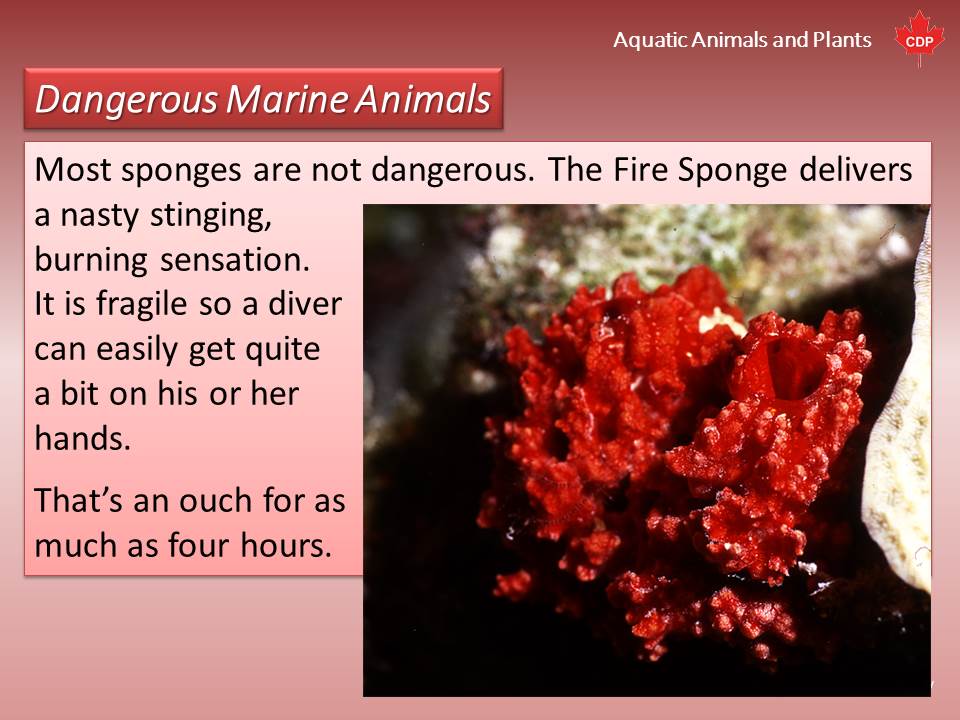 The fire sponge looks red in white light of a flash, but if you see it at depth, it will appear brown.It is a soft sponge so if you inadvertently lean on it you will be very sorry for several hours, but it is not fatal.
The fire sponge looks red in white light of a flash, but if you see it at depth, it will appear brown.It is a soft sponge so if you inadvertently lean on it you will be very sorry for several hours, but it is not fatal.
 Some of the deadliest animals in the world are small. If you encounter any of the things you see in this section, do not touch them if you can possibly avoid it. On this slide, the box jellyfish is one an entire family of jellyfish that are shaped like a box rather than circle. At least two of these species can be fatal if the stings are not treated right away. Others are more like intense bee stings. Diving in waters where these occur warrants wearing special clothing and protective masks.
Some of the deadliest animals in the world are small. If you encounter any of the things you see in this section, do not touch them if you can possibly avoid it. On this slide, the box jellyfish is one an entire family of jellyfish that are shaped like a box rather than circle. At least two of these species can be fatal if the stings are not treated right away. Others are more like intense bee stings. Diving in waters where these occur warrants wearing special clothing and protective masks.
 The most powerful stinging hydroids are usually found in caves, so be careful not to brush into them if you do enter a cave. The famous fire coral is actually not a coral, but a hydroid that has developed a stony skeleton similar to corals. Normally they are not much of a problem unless you have a cut or brush a tender part of your body (such as your underarm) against them.
The most powerful stinging hydroids are usually found in caves, so be careful not to brush into them if you do enter a cave. The famous fire coral is actually not a coral, but a hydroid that has developed a stony skeleton similar to corals. Normally they are not much of a problem unless you have a cut or brush a tender part of your body (such as your underarm) against them.
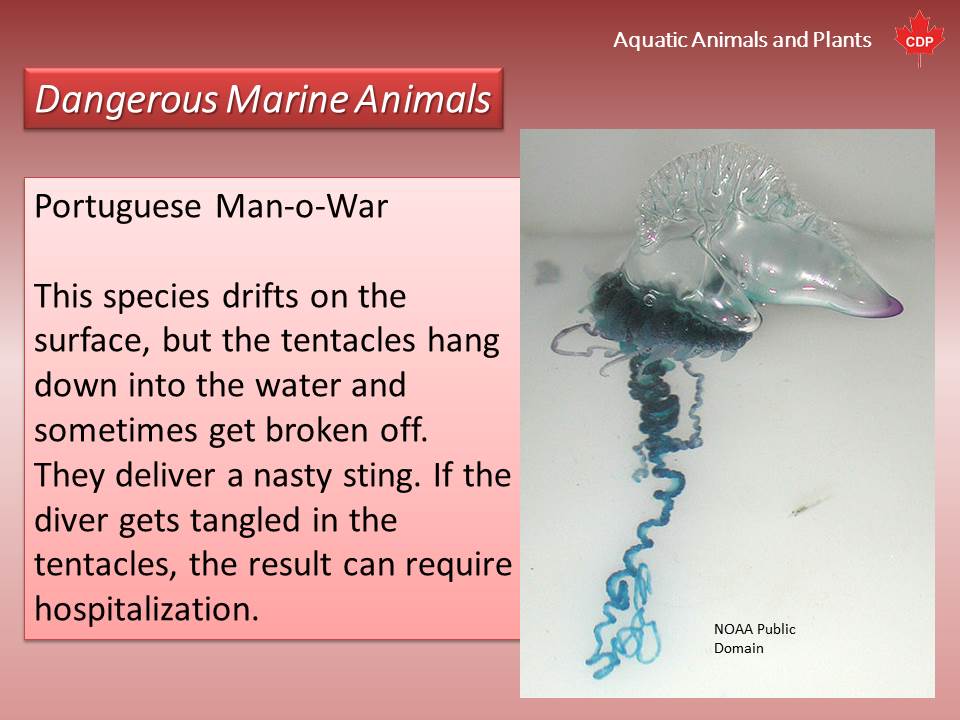 Portugese Man-o-War are surface floaters so but can have tentacles as much as 12 meters (40 feet) long. They have a powerful sting.
Portugese Man-o-War are surface floaters so but can have tentacles as much as 12 meters (40 feet) long. They have a powerful sting.
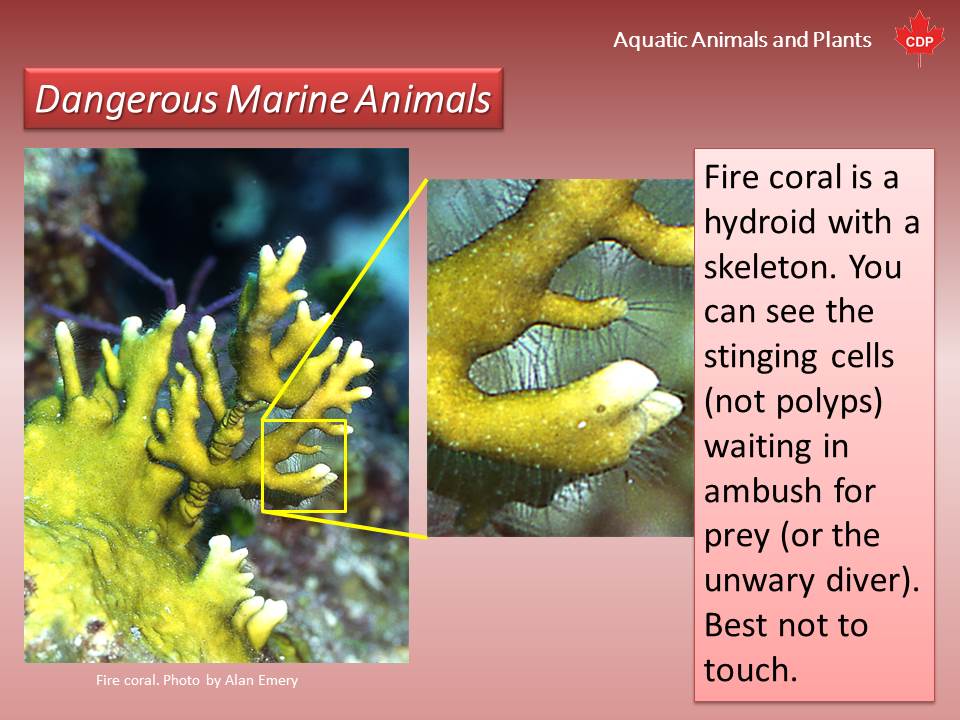
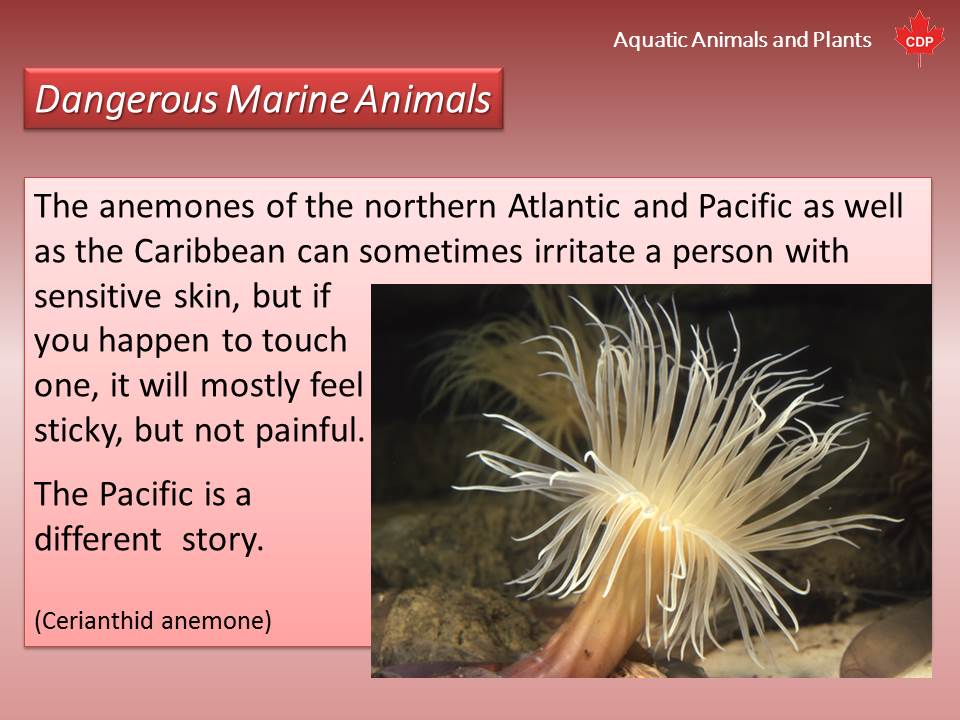
 Cone shells have a remarkable tongue or radula that has been modified into a harpoon. Large cone shells also have a venom gland associated with the harpoon to paralyse fish very quickly. It is so powerful that it can seriously injure a person or in some cases has caused deaths. Don’t touch, but if you need to pick one up for some reason, be aware that the harpoon can aim forward, sideways or even backwards, so pick the shell up by the crown with your fingers as far from the away from the slit as possible.
Cone shells have a remarkable tongue or radula that has been modified into a harpoon. Large cone shells also have a venom gland associated with the harpoon to paralyse fish very quickly. It is so powerful that it can seriously injure a person or in some cases has caused deaths. Don’t touch, but if you need to pick one up for some reason, be aware that the harpoon can aim forward, sideways or even backwards, so pick the shell up by the crown with your fingers as far from the away from the slit as possible.
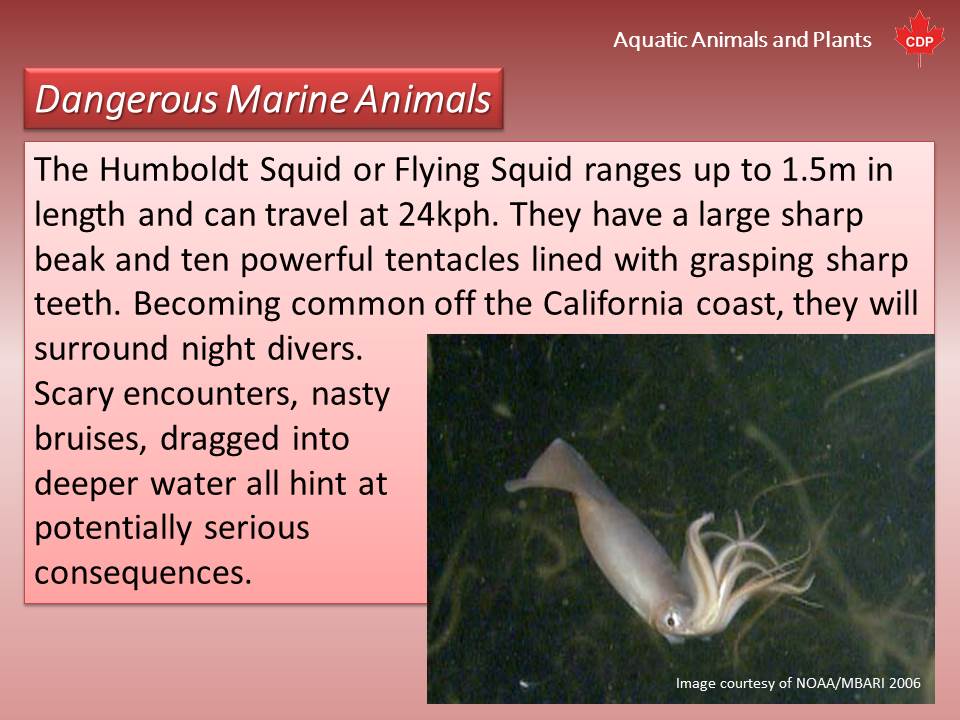 The Humboldt squid has recently extended its range northward due to climate warming. Divers in open water at night may find themselves in a rough and tumble group of them. They have grabbed divers and dragged them into deeper water, and routinely have hit them hard enough to cause significant bruising. They are an exciting animal to see, so some dive tours are offering cage dives to see them.
The Humboldt squid has recently extended its range northward due to climate warming. Divers in open water at night may find themselves in a rough and tumble group of them. They have grabbed divers and dragged them into deeper water, and routinely have hit them hard enough to cause significant bruising. They are an exciting animal to see, so some dive tours are offering cage dives to see them.
 Perhaps the most venomous is the blue-ringed octopus, a very small inconspicuous octopus in the Indo-Pacific. There is so far no known anti-venom for it bite. A diver who has been bitten may not even know it until a gradual loss of ability to move or breathe creeps over him or her. These bites are extremely difficult to treat successfully. Blue-ringed octopus feed on small crabs, hermit crabs, and shrimp that it hunts during the day. Two types of poison secreted by two separate poison glands are used against prey and predators. One of the poisons is used for hunting crab, the other, which is extremely toxic, is used as self-defense against predators. The poisons are secreted into the blue-ringed octopus’s saliva. The victim may not at first know he has been bitten because the bite is almost painless.
Perhaps the most venomous is the blue-ringed octopus, a very small inconspicuous octopus in the Indo-Pacific. There is so far no known anti-venom for it bite. A diver who has been bitten may not even know it until a gradual loss of ability to move or breathe creeps over him or her. These bites are extremely difficult to treat successfully. Blue-ringed octopus feed on small crabs, hermit crabs, and shrimp that it hunts during the day. Two types of poison secreted by two separate poison glands are used against prey and predators. One of the poisons is used for hunting crab, the other, which is extremely toxic, is used as self-defense against predators. The poisons are secreted into the blue-ringed octopus’s saliva. The victim may not at first know he has been bitten because the bite is almost painless.
The blue-ringed octopus is 12 to 20 cm (5 to 8 inches), but the venom of a single octopus is powerful enough to kill 26 humans (10,000 times more toxic than cyanide). There is no blue-ringed octopus anti-venom available.
The toxin is produced by bacteria in the salivary glands of the octopus. Their venom can lead to death by complete body paralysis within minutes if not treated. Death is usually from suffocation due to lack of oxygen to the brain.
Treatment is pressure on the wound and artificial respiration once the paralysis has disabled the victim’s respiratory muscles, which often occurs within minutes of being bitten. If you are alone with the victim this will be a very difficult job, but you will need to breathe for the victim for hours even if the patient appears unresponsive – they may just be paralysed.
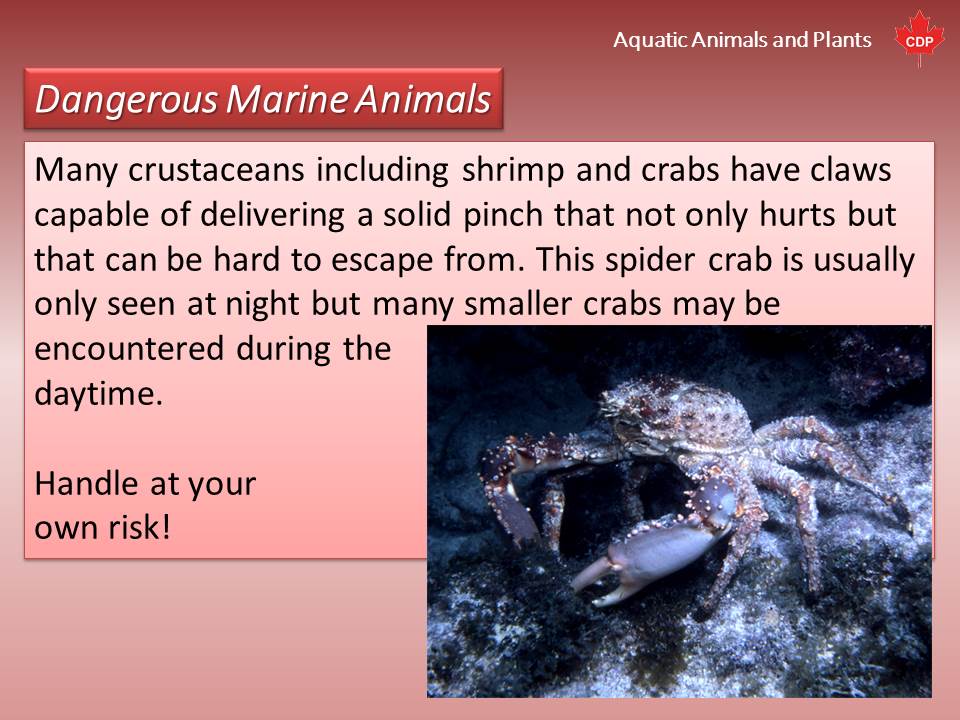
Lobsters, crabs, large mantis shrimp, and just about crustacean can either pinch or stab the unwary diver. In the Americas, there are no really deadly crustaceans.
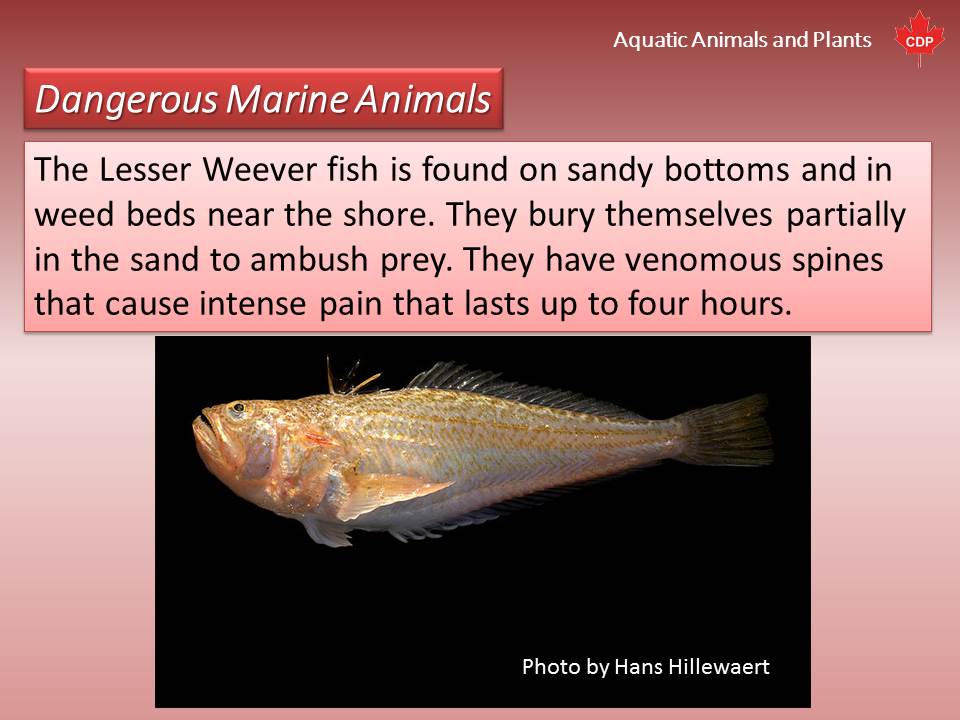
The lesser weever is generally found on the sandy seabeds of the open sea, near the shore in the eastern Atlantic. The lesser weever grows up to 18 cm long with an elongated body. Its is greyish-brown on the back and silvery-white on the sides. The sting of a weever is acute and intense. The pain frequently is radiated to the area around the limb. The pain reaches a maximum thirty minutes after the sting, and then slowly decreases. The best first aid is to wash the wound, and then immerse it in very hot water (40C – 45C) for at least an hour, in order to ease the pain and help destroy the protein-based venom. The sting is not fatal, but the pain is intense so the victim will need reassurance.
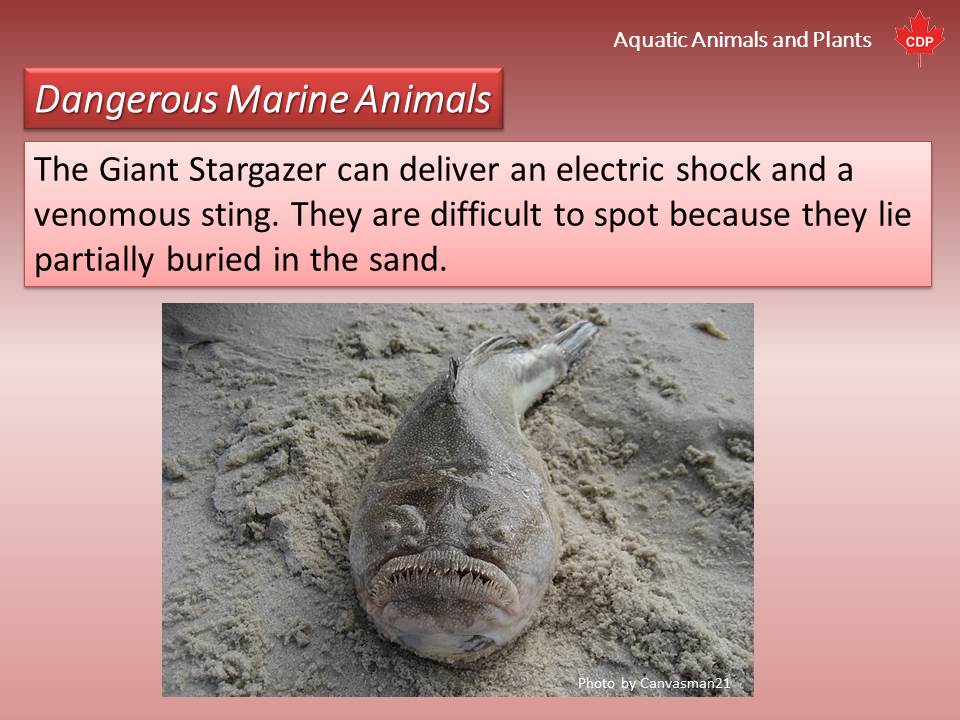
The stargazers have eyes on top of their heads (hence the name). In addition their mouth is both large and pointed upwards to capture unwary prey that swims over top of the fish. Some of the stargazers also have modification in their mouth that looks like a worm that they can wiggle to fool prey fish. They can grow to almost 90cm in length, so the electric shock is quite startling. The venomous spines are on the “shoulder” of the fish. Amazingly the electric organs are actually modified eye muscles. Also very strange: they cannot detect electric pulses even though they can make them.
Interactions with divers are not common with this species. While it is large, it is also a sluggish fish spending a great deal of time resting on the bottom. Because of the ferocious looking saw and because the sawfish uses this saw as a killing device (albeit for small fish) it is always wise to respect the potential of this fish to inflict major injuries. Fishermen who catch them always secure the saw first.
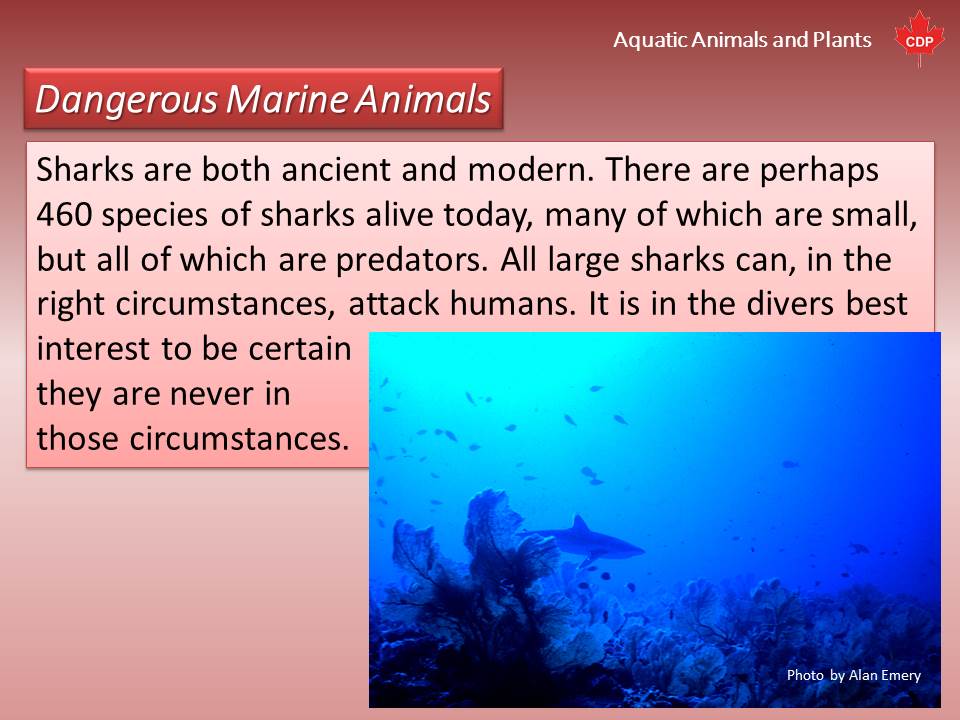
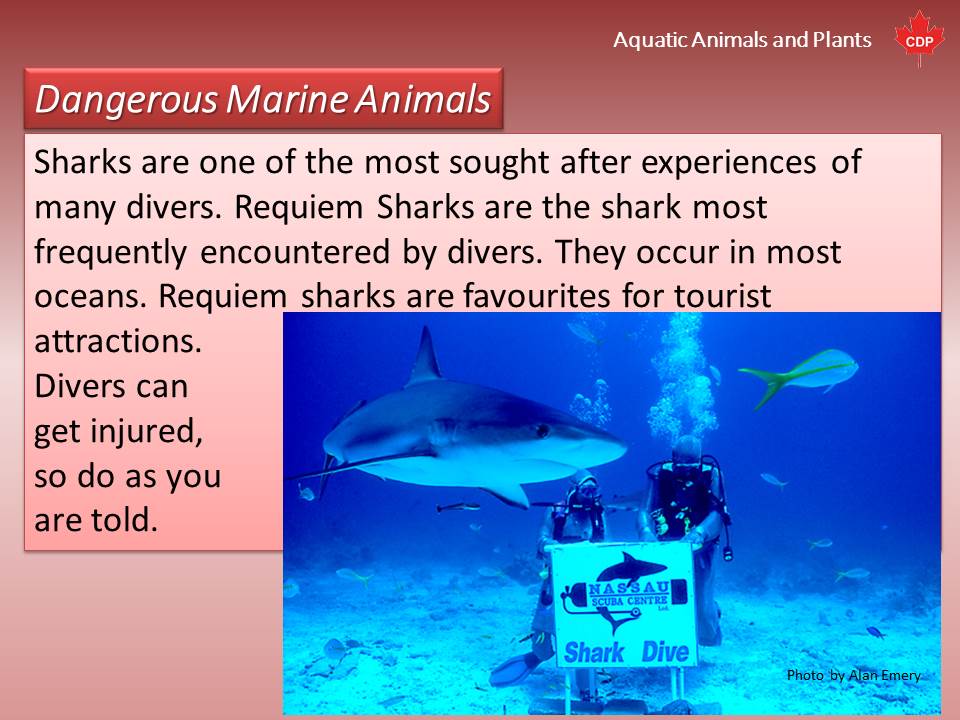

There have been some forty-two attacks recorded on humans between 1980 and 2010, three of which were fatal. This shark is regularly blamed for attacks on humans and, due to its speed, power and size, it is certainly capable of injuring and killing people. However, Makos don’t routinely attack humans. Most attacks involving mako sharks have probably been provoked. Makos are so powerful that large ones can create a cavitation slap with their tails. They warn of an impending attack by swimming in a figure eight pattern and approaching with mouths open. Because their teeth are showing normally, this is an impressive sight.
This species’ color is brilliant metallic blue on its back and white on its belly with a sharp demarcation between the white and blue. By contrast, the Blue shark is a deep indigo above, shading to blue then white.
The juvenile mako often has a black mark on the tip of the snout. The Longfin Mako very much resembles the Shortfin, but has larger pectoral fins, dark rather than pale coloration around the mouth and larger eyes.
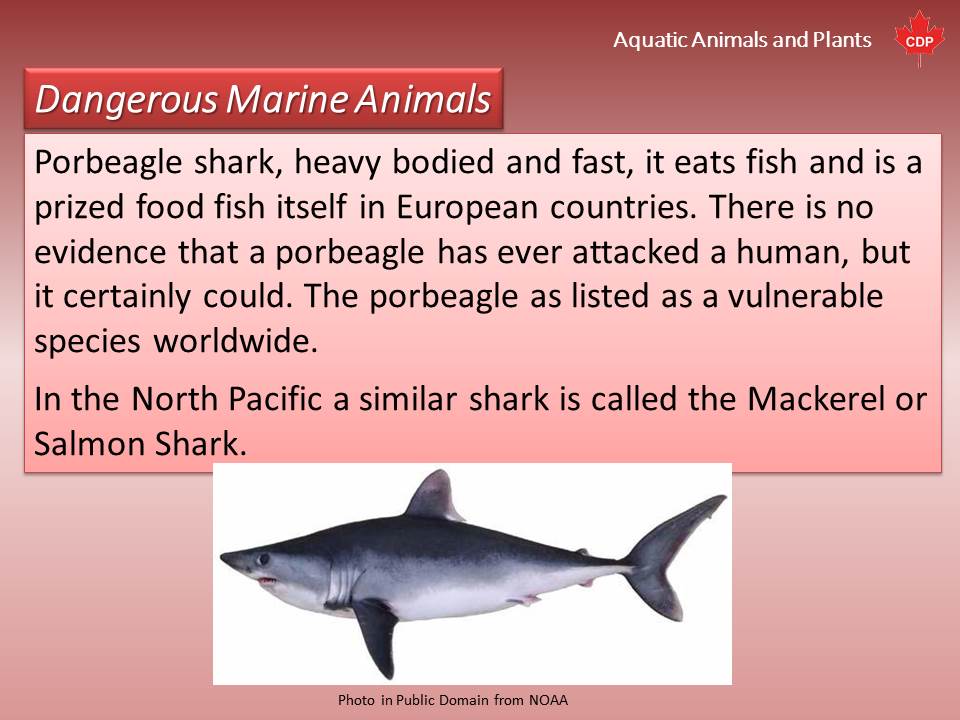
The porbeagle is widely distributed in the cold and temperate marine Atlantic waters. The salmon shark is a similar species in the North Pacific. The porbeagle is usually about 2.5 m (8.2 ft) in length and a weight of 135 kg (300 lb) in weight. The porbeagle has a very stout midsection that tapers towards a long, pointed snout. The base of the tail is very narrow. The easiest external mark for this species is a white blotch at the at the rear base of the first (large) dorsal fin. There is not much real evidence that a porbeagle has attacked a human, but it certainly could. The porbeagle is listed as a vulnerable species worldwide.
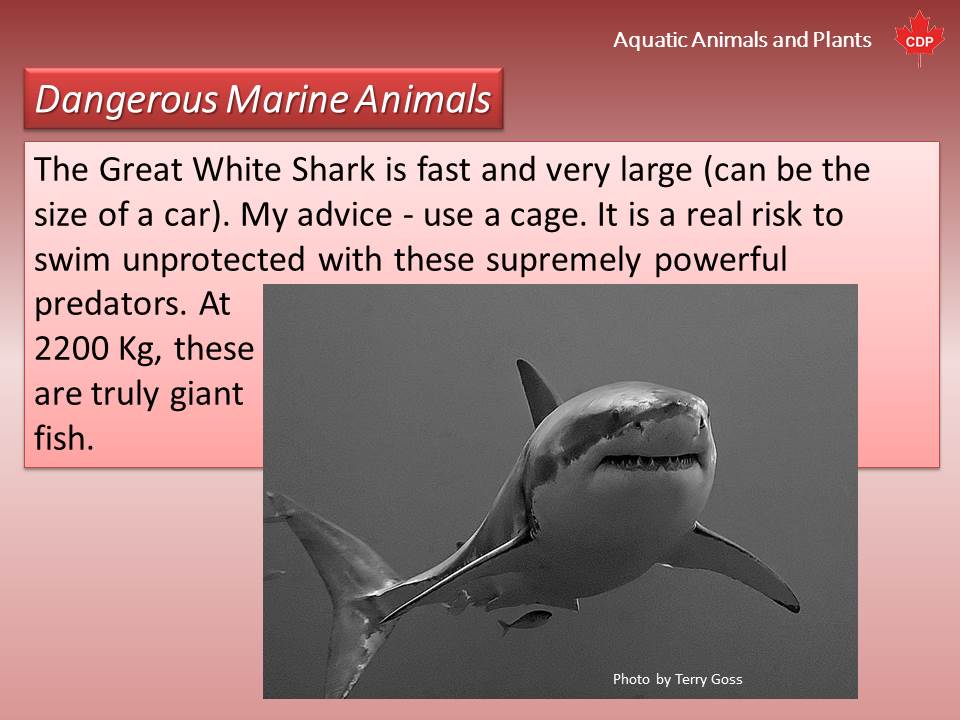
Great white sharks are stealth hunters. They attack primarily by swimming up from underneath the prey and biting quickly then letting go. They then wait for the prey to bleed to death so they can eat it without getting any defensive reaction. This means if you see a Great White you are probably OK for a while until it gets curious. These are very smart animals and learn quickly. Head for the anchor and then the boat keeping your eye out for the shark’s actions. This species does not bother with threats, but it is cautious. It is found in the coastal surface waters of all the major oceans, but can swim vast distances through open ocean. The great white shark is mainly known for its size, with the largest individuals known to have approached or exceeded 6 m (20 ft in length, and 2,268 kg (5,000 lb) in weight. This shark matures at about 15 years of age and can live more than 30 years. The great white shark is ranked first in having the most attacks on humans. Usually the shark ambushes and bites its prey from below, then waits for it to bleed to death before moving in to feed. Solo divers are less likely to survive a white shark attack. Divers operating with buddies are often rescued by their buddies before the white shark returns to feed. A diver with help can move out of reach with the help of others. Seals cannot do this so the shark is not easily able to adapt to the unusual behaviour of its prey. Fatalities are usually caused by blood loss from the initial bite rather than from critical organ loss or from whole consumption. Since 1990, there have been a total of 139 unprovoked great white shark attacks, 29 fatal.
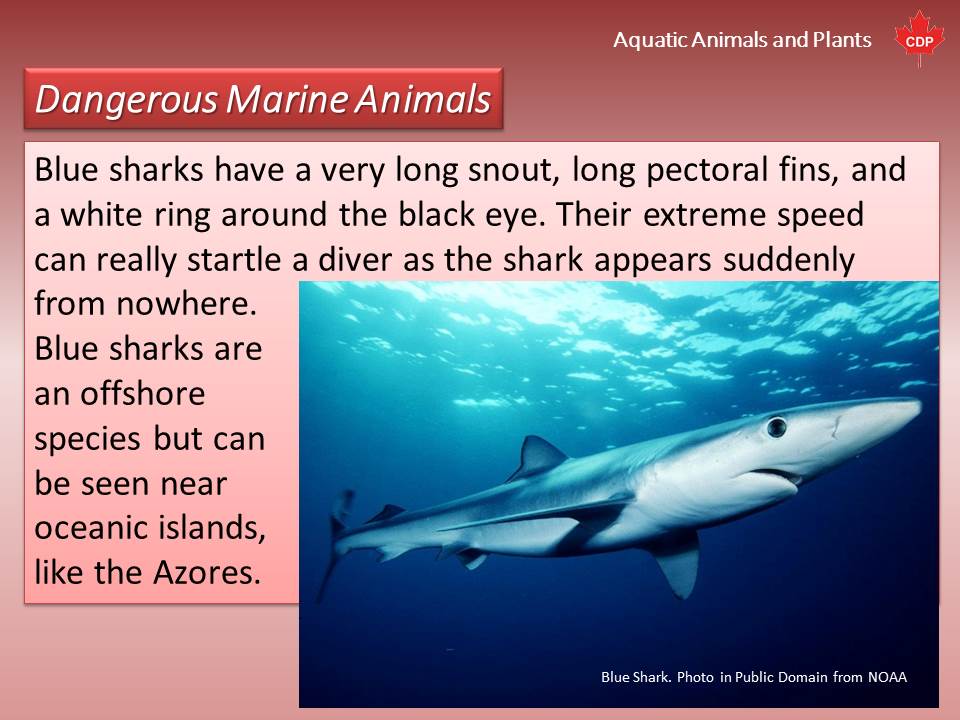 Blue sharks are very slender when they are young. They are also very active, hunt in packs (called “wolves of the sea”) and may bite unwary divers. Blue sharks get very large, but the big ones are mostly offshore. Blue sharks are light-bodied with long pectoral fins. The top of the body is deep blue, almost indigo, lighter on the sides, and the underside is white. Blue shark often reaches 2.5 m (8.5ft) at maturity. Large specimens can grow to 4 m (12.5) long. They can swim very fast. They are often reported at 35-50kph. It inhabits deep pelagic waters and feeds mainly on cephalopods. The Blue Shark is highly threatened by long-line fishing, both as a target and as bycatch. In the IUCN (International Union for Conservation of Nature and Natural Resources) Red List is classified as Near Threatened.
Blue sharks are very slender when they are young. They are also very active, hunt in packs (called “wolves of the sea”) and may bite unwary divers. Blue sharks get very large, but the big ones are mostly offshore. Blue sharks are light-bodied with long pectoral fins. The top of the body is deep blue, almost indigo, lighter on the sides, and the underside is white. Blue shark often reaches 2.5 m (8.5ft) at maturity. Large specimens can grow to 4 m (12.5) long. They can swim very fast. They are often reported at 35-50kph. It inhabits deep pelagic waters and feeds mainly on cephalopods. The Blue Shark is highly threatened by long-line fishing, both as a target and as bycatch. In the IUCN (International Union for Conservation of Nature and Natural Resources) Red List is classified as Near Threatened.
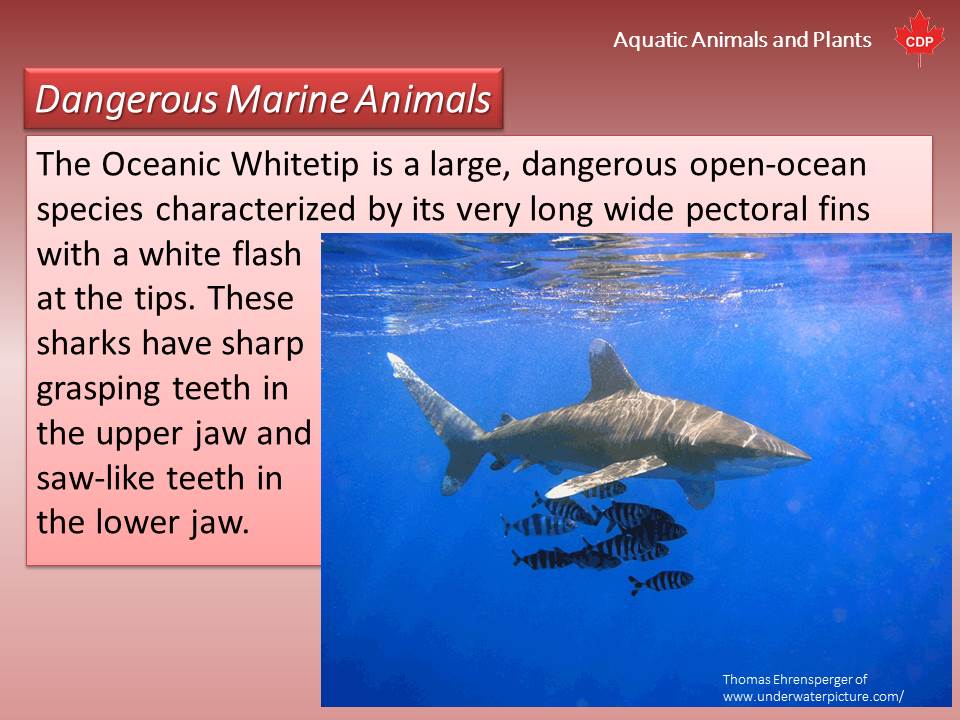
This aggressive but slow-moving fish is a danger to shipwreck or air crash survivors because it congregates around material at the surface. Unfortunately due to over exploitation largely because of the shark-fin soup industry, the white tip is declining in numbers very quickly throughout its range in warm temperate and tropical water.
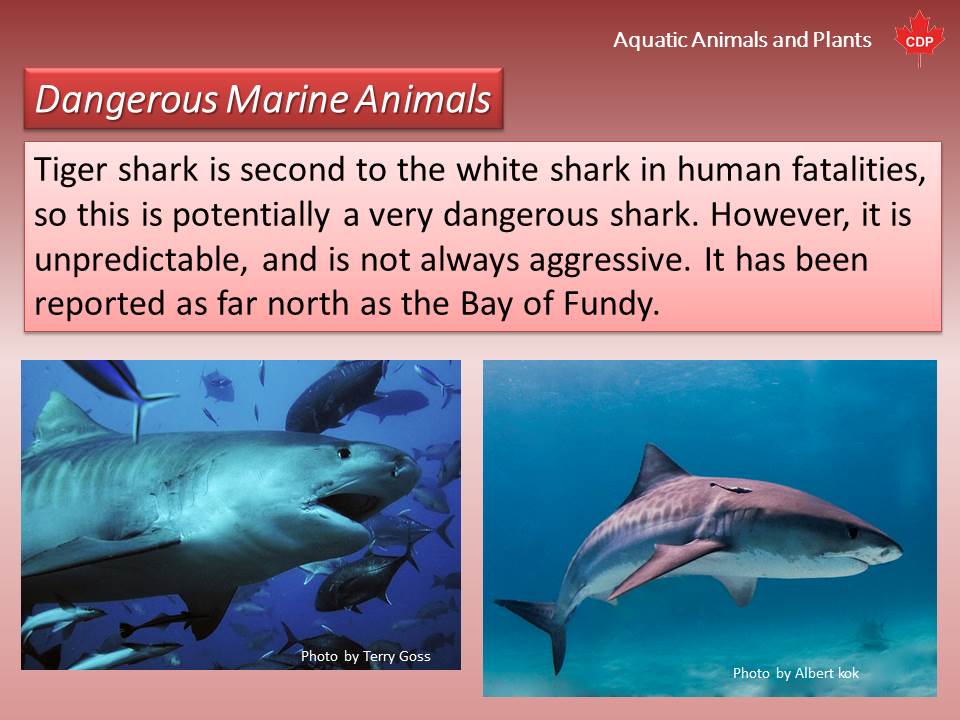
The tiger shark is a very large requiem shark and can reach lengths of about 5m (16ft). In most specimens (but not all) there are dark stripes down the sides of its body. The tiger shark is one of the sharks most dangerous to humans, second only to the great white shark. On average, three to four shark tiger shark attacks per year in Hawaii alone, but most attacks are not fatal.
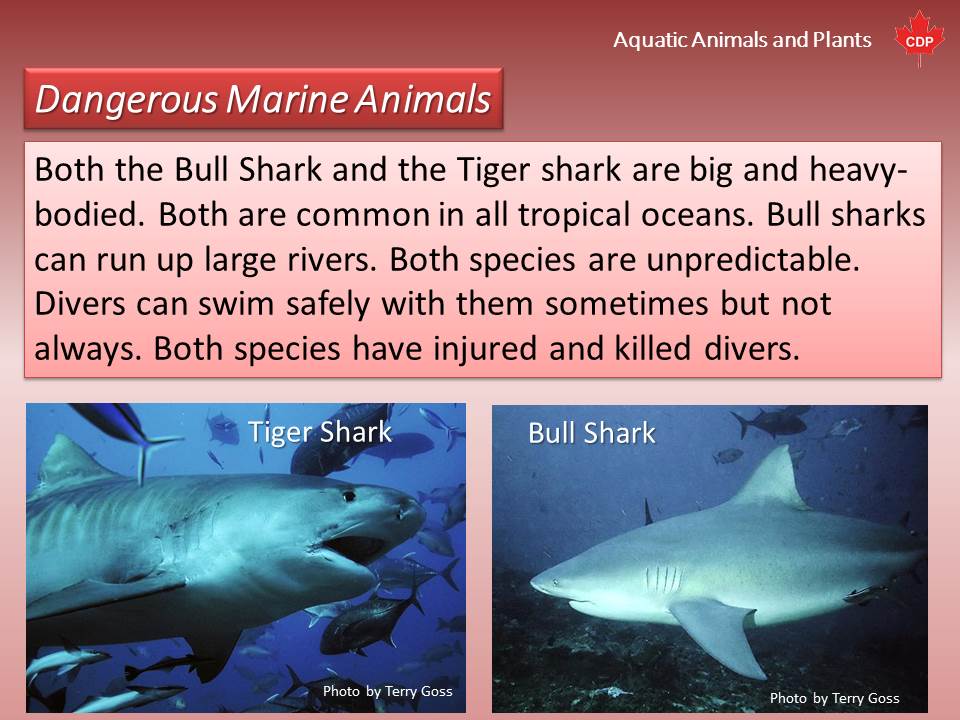
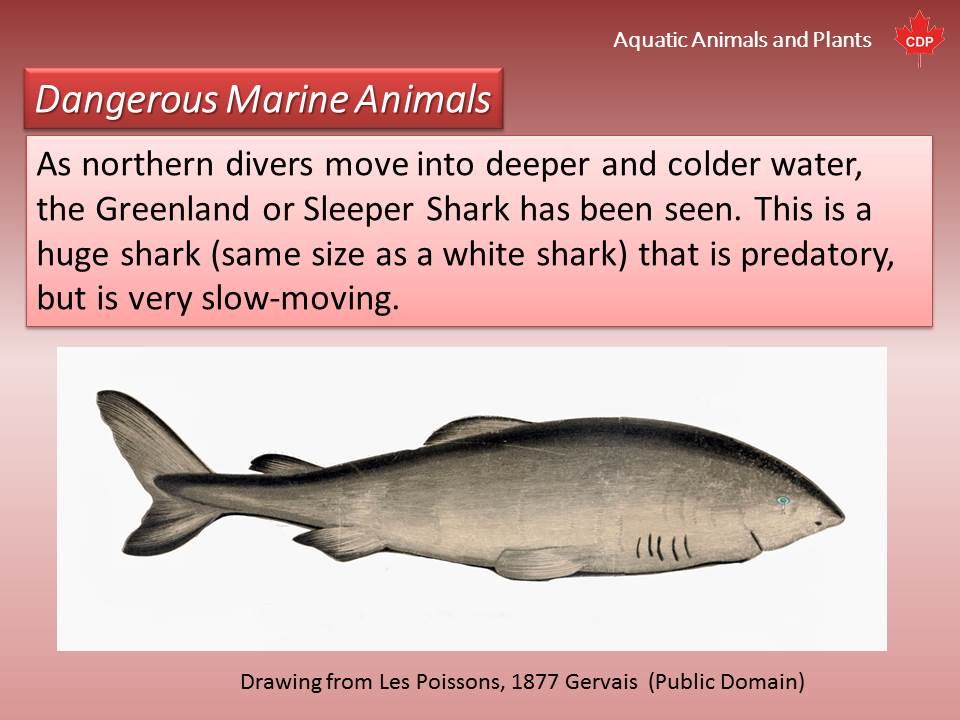
This is one of the largest living species of predatory shark, of dimensions comparable to those of the great white shark. The Inuit name for this shark is Eqalussuaq. These sharks live farther north than any other shark species.
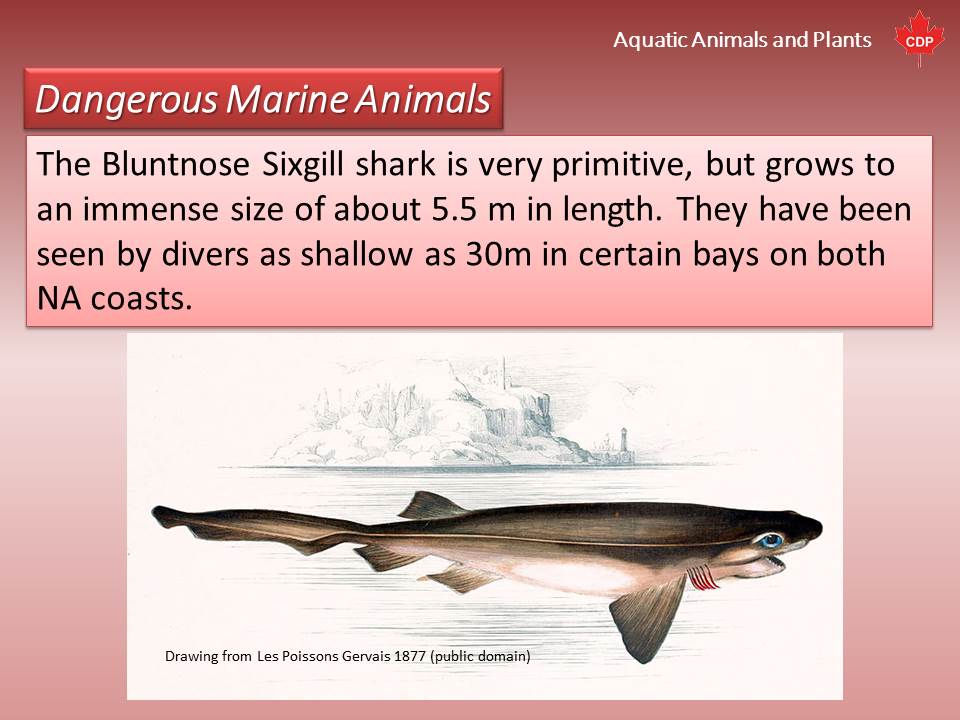
The bluntnose sixgill shark is related to the dogfish and the Greenland shark. They have one dorsal fin located just in front of the tail. The pectoral fins are broad with rounded edges. Unlike most sharks the diver will see, these species has six gill slits rather than the usual five.
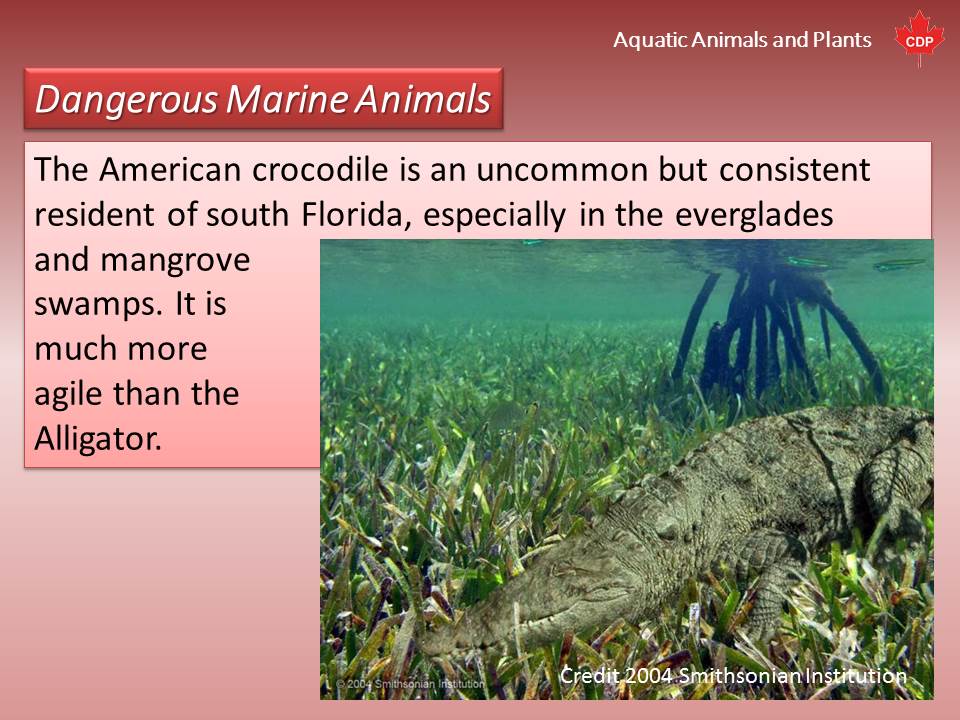
Most divers in Florida will never see an American Crocodile, and in fact seeing an alligator in the sea often results in the diver misidentifying the animal as a crocodile. Both Alligators and Crocodiles can swim in the sea, but the American Crocodile has a specific salt tolerance adaptation. As global warming continues, the American Crocodile like many other warm water species will continue to extend their range northward. So far the American Crocodile has been spotted as far north as South Carolina. There are additional species in Cuba and Mexico. The few encounters recorded by divers report that the crocodiles are wary and move away. However, this species has killed humans, and it is large, so the best strategy is extreme caution.
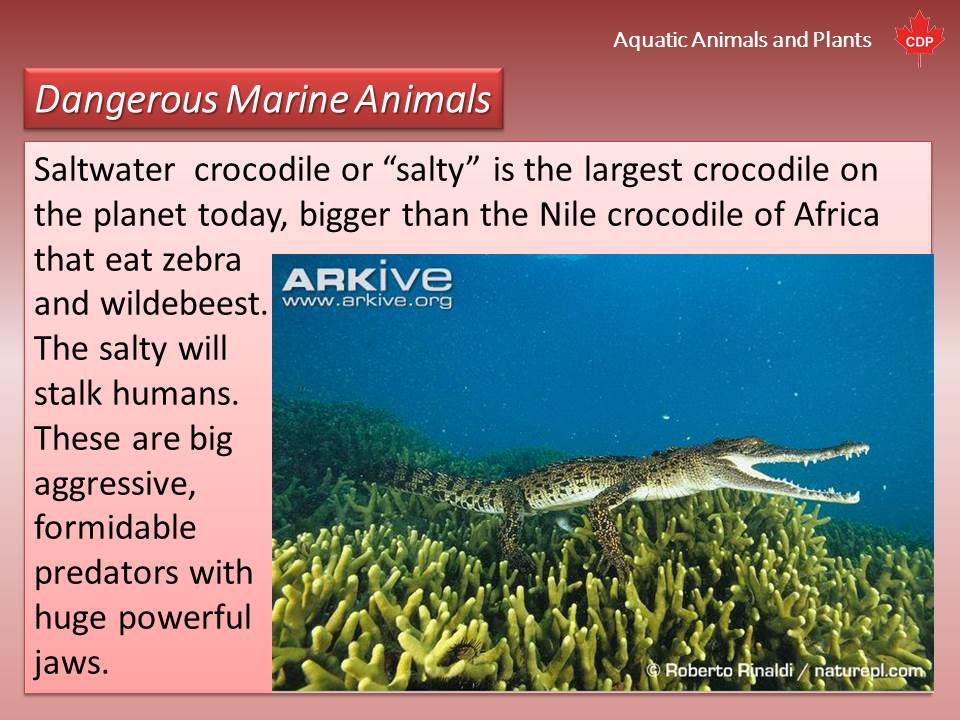
I have included this species just because it is the biggest and nastiest beast you will ever encounter in the water. Although sharks are more likely to be in the presence of a diver, these crocodiles are regularly seen from dives in the tropical Pacific, although not on North American coasts. If a big crocodile of this species gets to you it is unlikely you will survive, so get out of the water if you see one. They will even jump to catch a dangling arm over the side of a boat. Like all crocodilians, it uses the “death roll” to tear limbs and flesh from its prey. Sensory organs in the skin around its jaws enables it to sense tiny pressure changes in the water, such as those caused by bubbles or divers moving below the surface. I have seen them underwater and they are very fast swimmers chasing down fish. On land they can jump over 3 meters and run faster than a human. Impressive beasts.
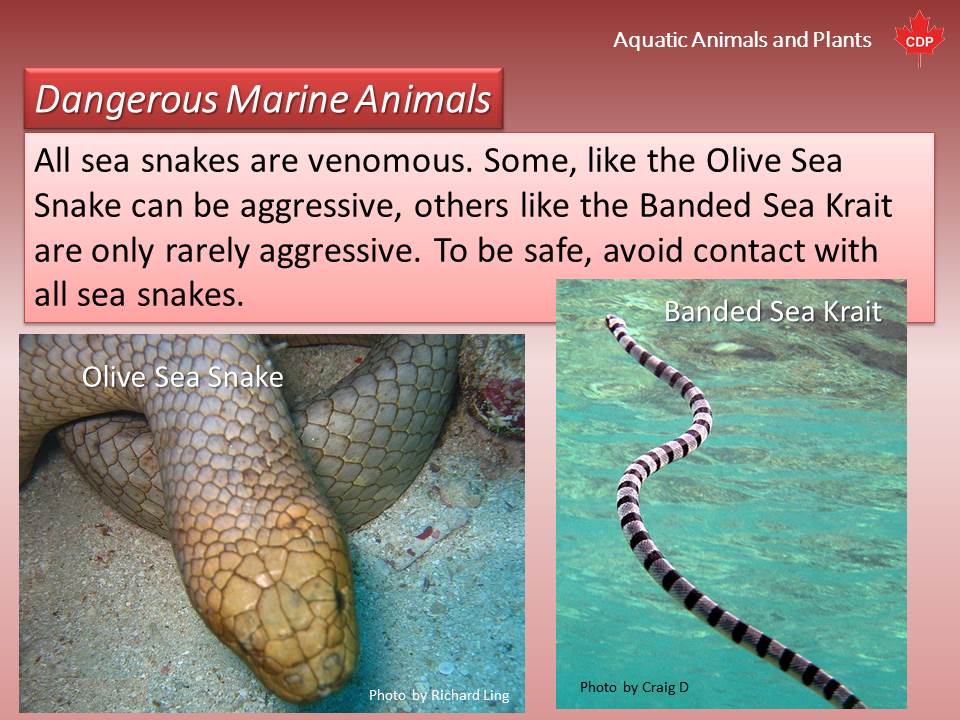
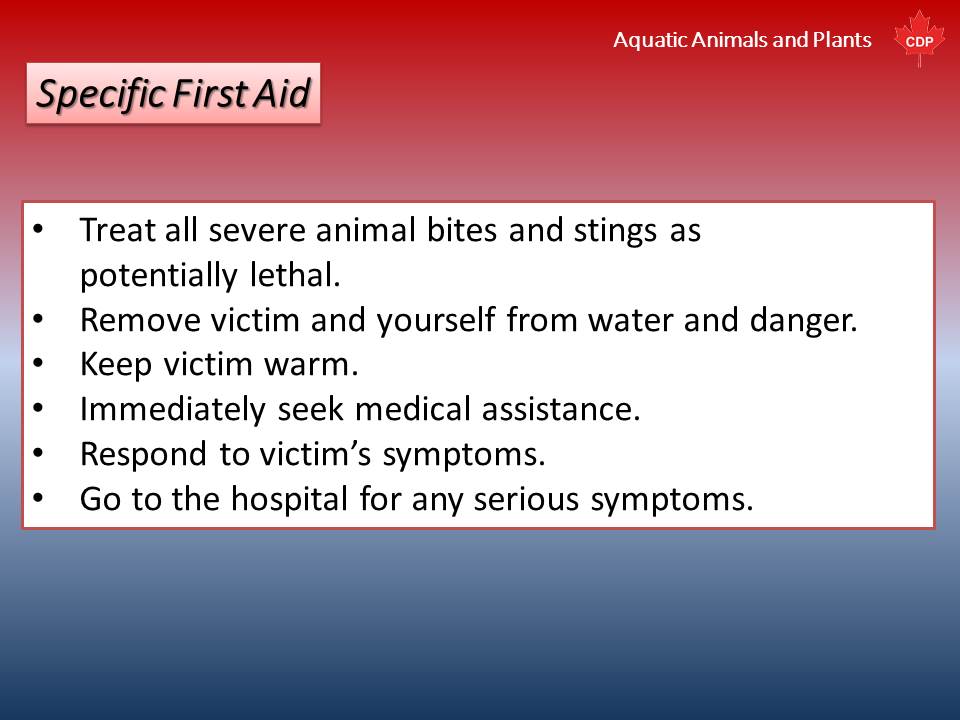 The advice offered here is derived from current literature on the topic of managing victims with injuries from dangerous animals. It should not be considered definitive advice as there will always be updates as medical science learns from experience and experimentation. The best advice is to react to the victim’s symptoms once he or she is in a warm safe place while simultaneously and urgently seeking expert medical assistance.
The advice offered here is derived from current literature on the topic of managing victims with injuries from dangerous animals. It should not be considered definitive advice as there will always be updates as medical science learns from experience and experimentation. The best advice is to react to the victim’s symptoms once he or she is in a warm safe place while simultaneously and urgently seeking expert medical assistance.
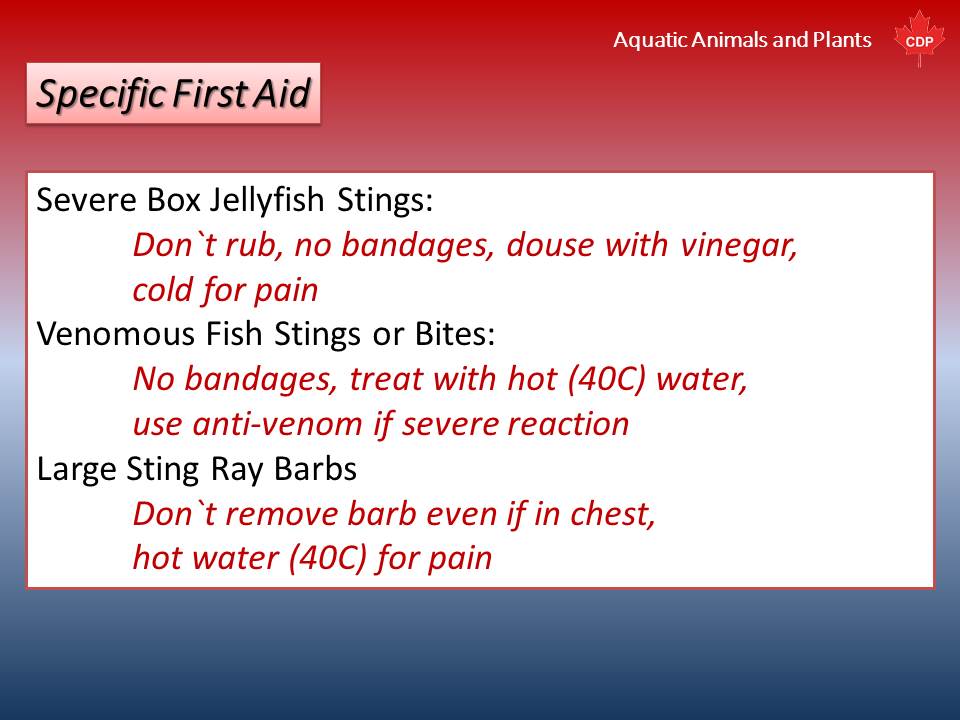 In severe box jellyfish stings such as Chironex or Irukandji, time is of the essence in removing the victim from danger. By dousing the wound and any attached tentacles with vinegar, the nematocysts will not be able to fire. Attempting to remove tentacles will make matters much worse. Do not allow the victim to rub the wounds or try to remove the tentacles. Restraining the victim may be difficult as the pain is intense. Try to reassure and apply cold to reduce the pain. Do NOT apply any pressure systems as that will just fire the nematocysts and help them penetrate the skin.
In severe box jellyfish stings such as Chironex or Irukandji, time is of the essence in removing the victim from danger. By dousing the wound and any attached tentacles with vinegar, the nematocysts will not be able to fire. Attempting to remove tentacles will make matters much worse. Do not allow the victim to rub the wounds or try to remove the tentacles. Restraining the victim may be difficult as the pain is intense. Try to reassure and apply cold to reduce the pain. Do NOT apply any pressure systems as that will just fire the nematocysts and help them penetrate the skin.
There are many species of fish that can deliver venom by injections from spines. Most are very painful, but a few are potentially lethal, especially those of the stonefish and related scorpion fish. Stonefish injuries are usually in the feet or hands. Victims can succumb quickly, so if the reaction is severe, attempt to get anti-venom as fast as possible. There are similar-looking scorpion fish in the Atlantic and Caribbean, but they are not usually lethal. Recently introduced Indo-Pacific lionfish can also inflict a very painful wound. There is now a “Lionfish First Aid Kit” available which was developed by the Bahamas National Lionfish Response Project. It uses a heat pad, but hot water (45C) applied for 30 to 90 minutes works as well if it is available. Because most of these venoms are made of proteins, heat will deactivate them. Be careful not to scald the victim – test the water first with your own hand.
Sting rays, especially large ones can kill a person by driving the barb into the chest of a diver. So the first order of business is never to swim over top of a sting ray. Divers or waders hit by large sting rays suffer immediate and intense pain sufficient to reduce even a very strong man to a shivering mess. It is tempting to remove the barb, but do NOT remove the barb. The barbs have backwards pointing spines that will rip and tear flesh if it is pulled out. Let the hospital remove the barb. Do not remove the barb even if it is driven into the chest and heart. Several people have survived these injuries by leaving the barb in place in the chest. Steve Irwin (“crocodile hunter”) pulled the barb out of his own chest and died within minutes of doing so. Even small sting rays can do significant damage with their barbs so even if the barb is gone, be sure to go to the hospital because there is venom in a groove along the underside of the barb that is left behind in the wound.
 One of the keys to successful treatment is to move the victim as little as possible. Any movement or action tends to move the poison into the system. The PIB and splint helps to slow the travel of the poison, but it also helps to prevent motion on the part of the victim. Sea snakes are more venomous than any land snakes. They are related to cobras. So a sea snake bite is dangerous. Fortunately bites are rare. Some sea snakes can be handled without danger, but others cannot. Do not take any chances even with a small sea snake. Each snake has enough venom to kill three people.
One of the keys to successful treatment is to move the victim as little as possible. Any movement or action tends to move the poison into the system. The PIB and splint helps to slow the travel of the poison, but it also helps to prevent motion on the part of the victim. Sea snakes are more venomous than any land snakes. They are related to cobras. So a sea snake bite is dangerous. Fortunately bites are rare. Some sea snakes can be handled without danger, but others cannot. Do not take any chances even with a small sea snake. Each snake has enough venom to kill three people.
Interestingly the open ocean sea snake called the Yellow-Bellied Sea Snake is probably the most common reptile on the face of the earth. They sometimes form large islands (many kms across and long) in the open ocean. There are anti-venoms available for both sea snakes and for water moccasins. If you have access to them, use them as soon as you see severe signs of stress.
There is no blue-ringed octopus anti-venom available. So don’t waste time searching for that type of assistance. The toxin is produced by bacteria in the salivary glands of the octopus. Their venom can lead to death by complete body paralysis within minutes if not treated. Death is usually from suffocation due to lack of oxygen to the brain. Because there is whole body paralysis (a bit like curare) artificial respiration is going to be needed. If you can get a respirator bag system going, that is the best approach. If you are alone with the victim this will be a very difficult job, but you will need to breathe for the victim for hours even if the patient appears unresponsive – they may just be paralysed. Treatment is pressure on the wound and artificial respiration once the paralysis has disabled the victim’s respiratory muscles, which often occurs within minutes of being bitten.
The most dangerous sharks are those that do not offer a warning threat and are very large. These include the Great White, the Blue Shark, The Bull Shark, The Oceanic White Tip and The Tiger Shark. While each has a different technique of attack, the resulting bite is often so horrendous that the victim bleeds to death in a few minutes. Rapidly stopping the bleeding and treating for shock are the primary first responses, once the victim and rescuer are out of the danger zone. Many people have lost limbs or had enormous bites removed from their bodies and still lived to tell the tale. So victims are encouraged to fight back against the shark. Do not give up. Rescuers should do all possible to stabilize the victim.In all cases of shark bites and barracuda bites, the victims uniformly describe being bitten as not painful. They feel a tug or pull or bump. This means there is a clean sharp bite and little immediate shock. So coherent action is a possibility for some time. However the shock does set in after some minutes.
Moray bites are usually considerably less severe, but two morays, the green in the Caribbean and Atlantic, and the Giant Moray in the Pacific can inflict major lacerations or remove fingers.






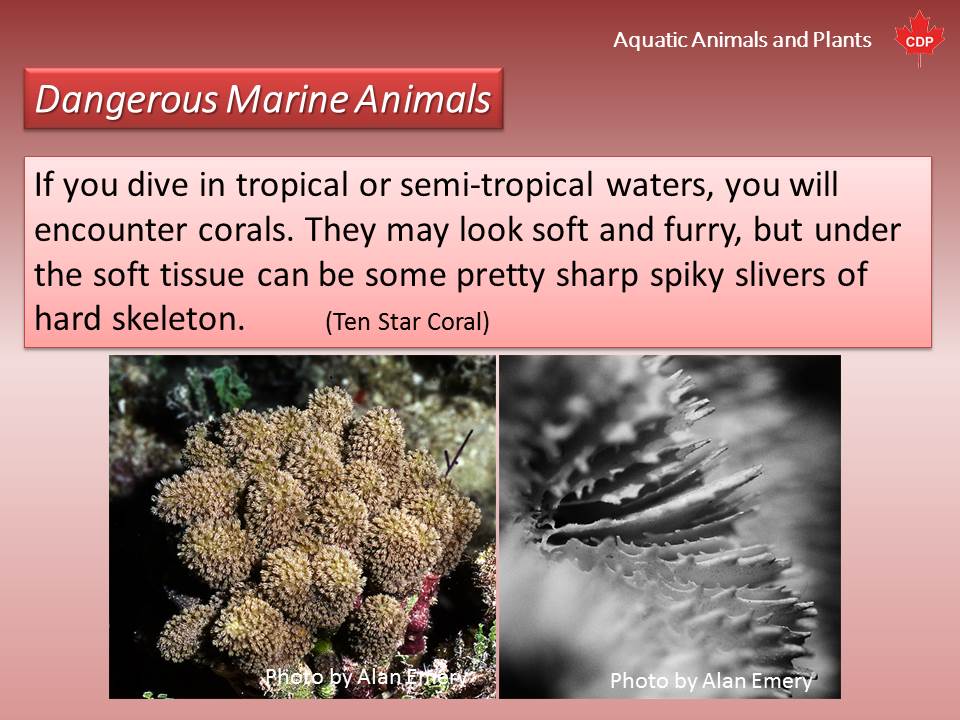
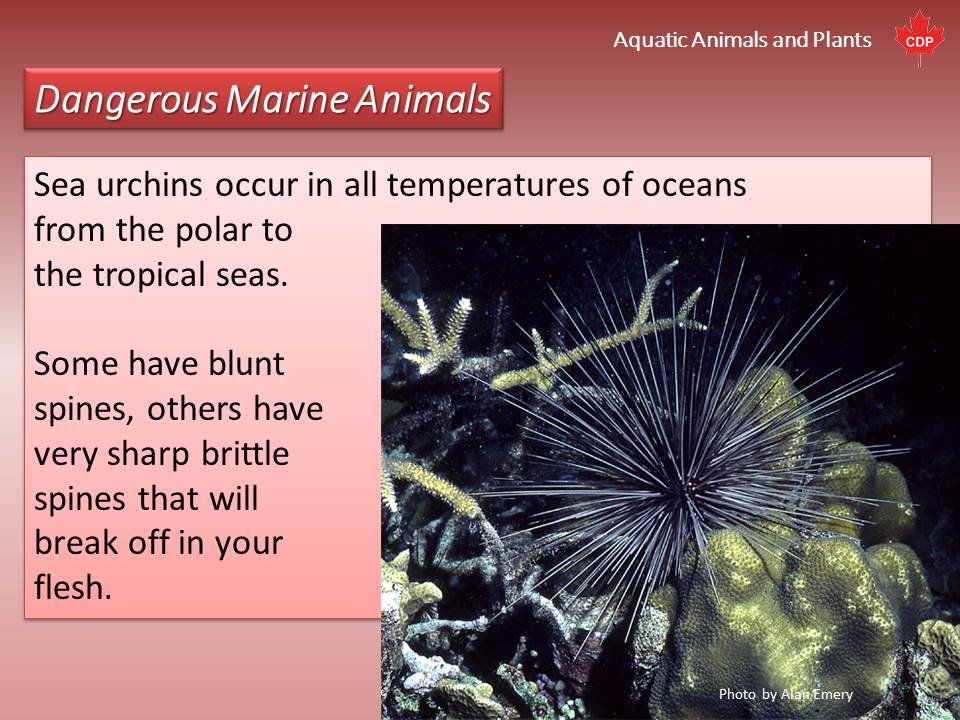
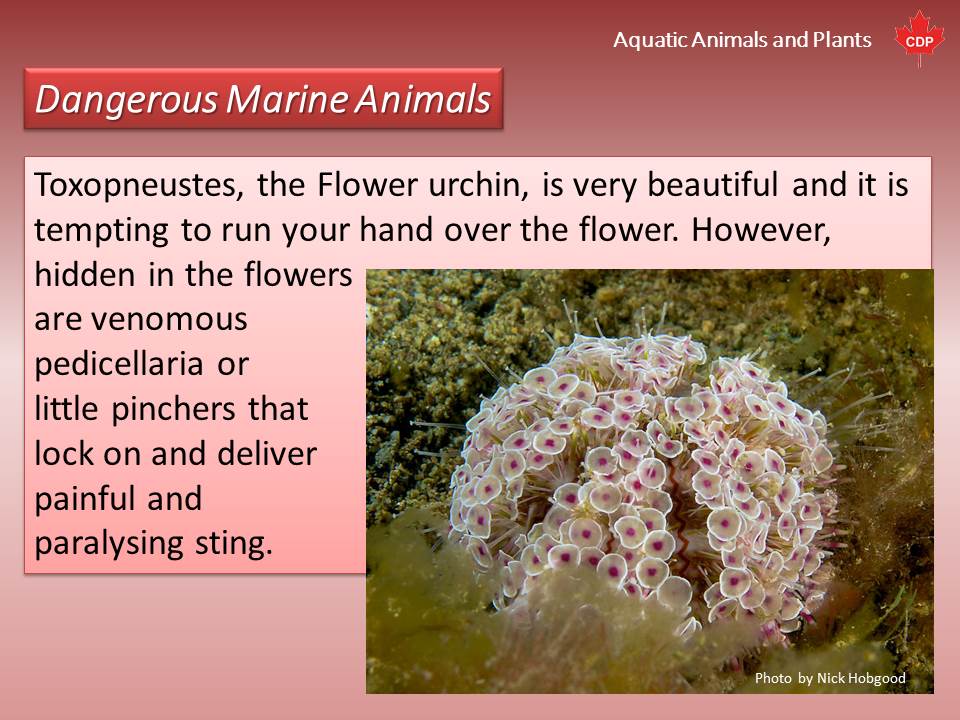

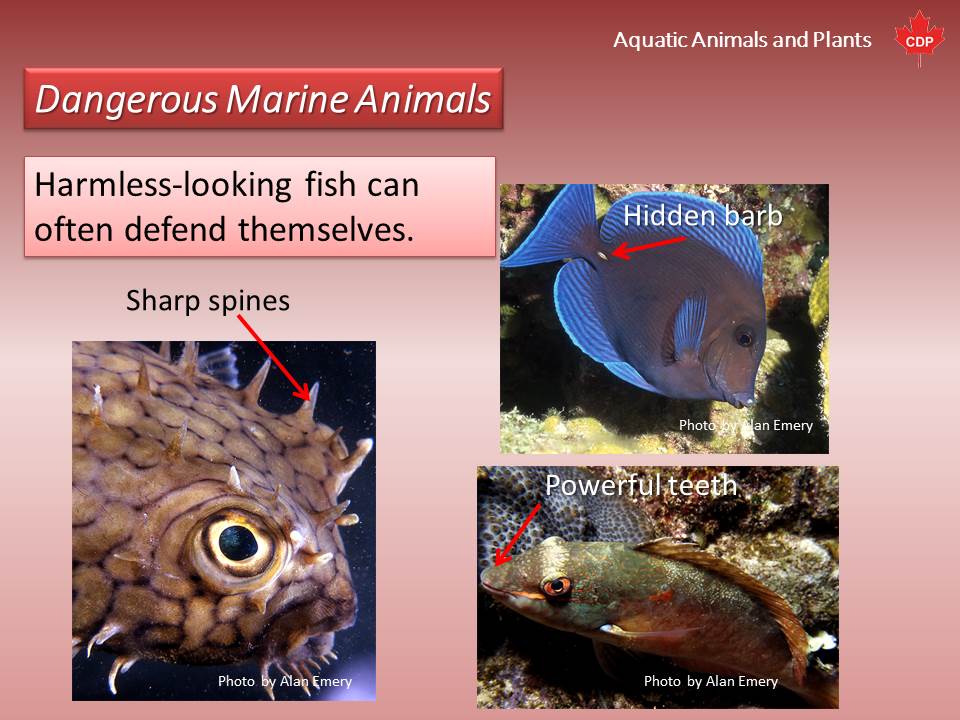

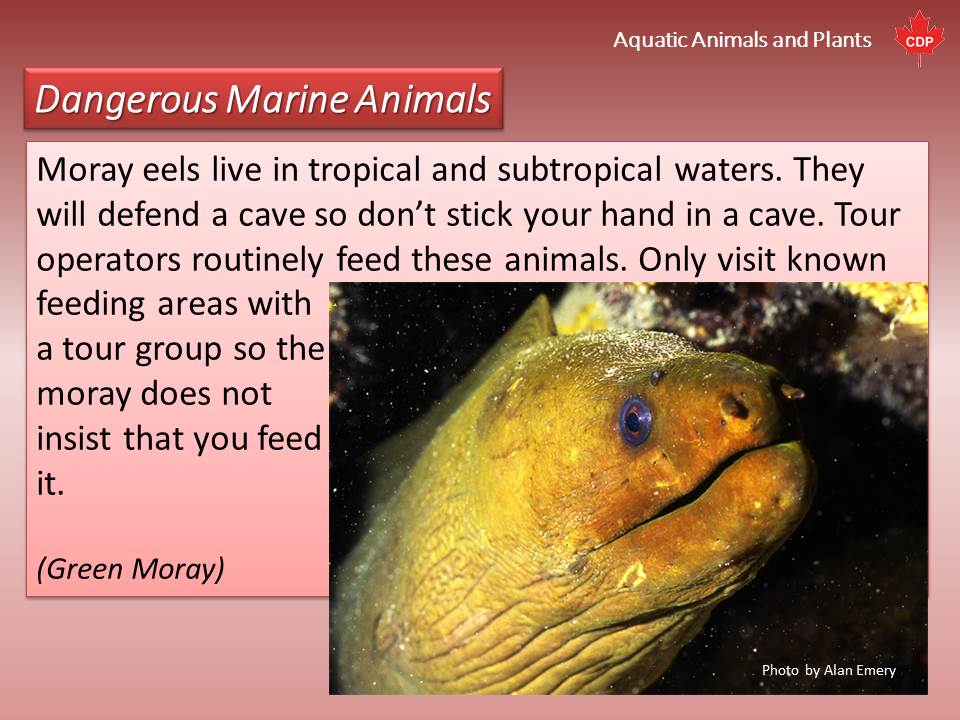
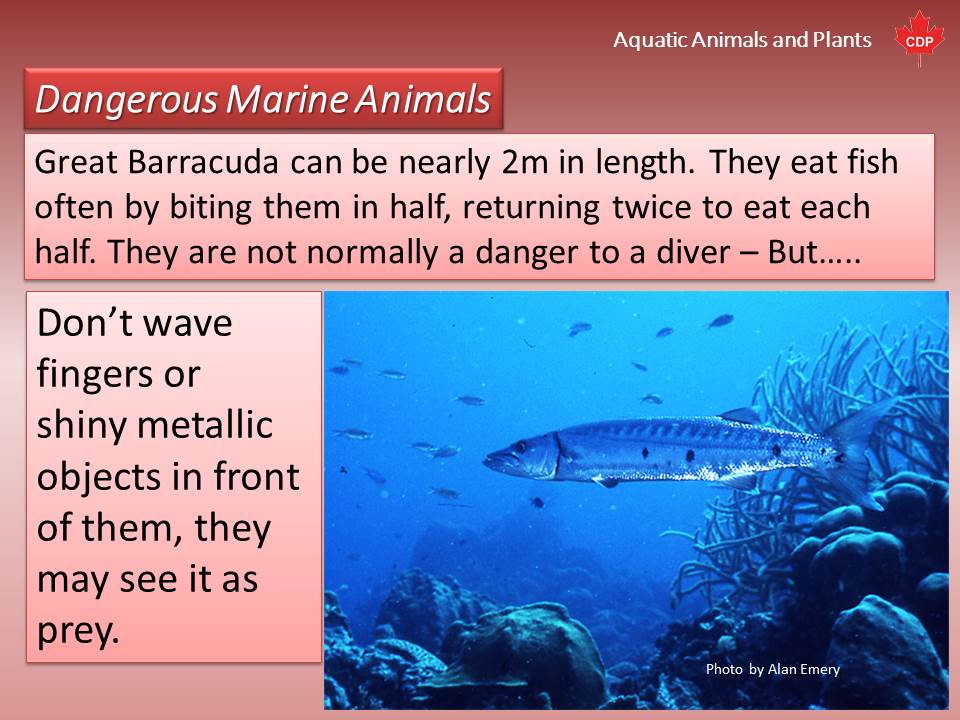
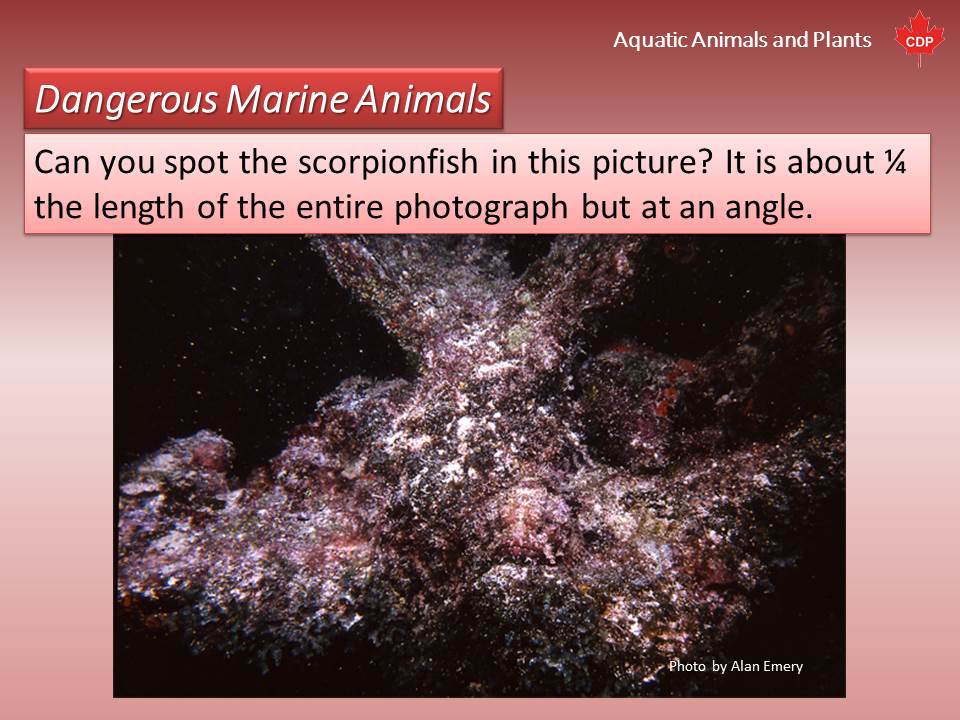
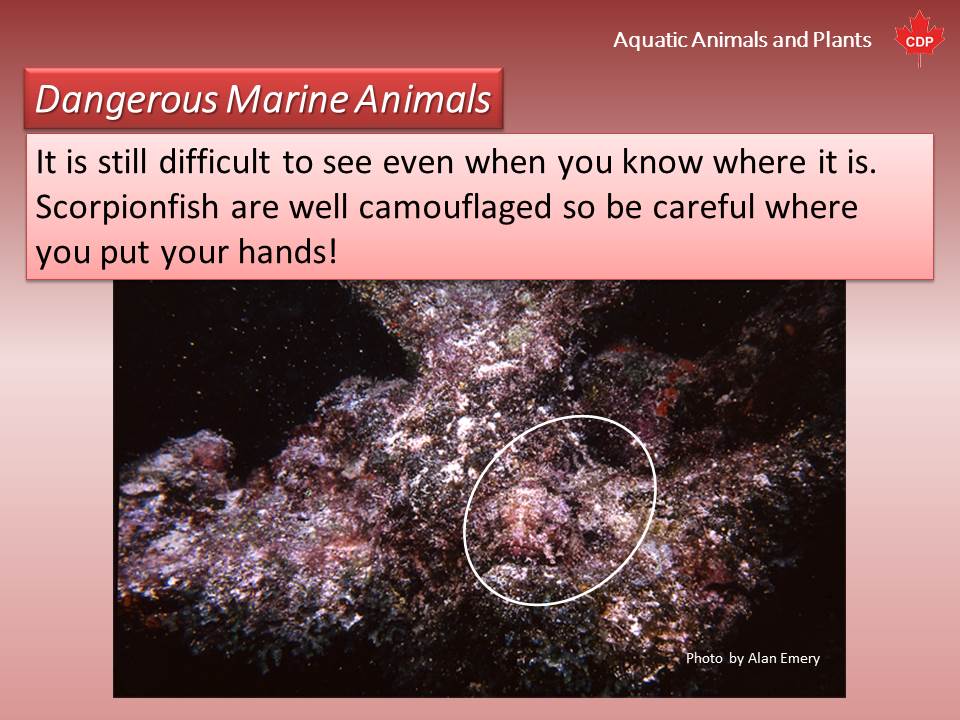
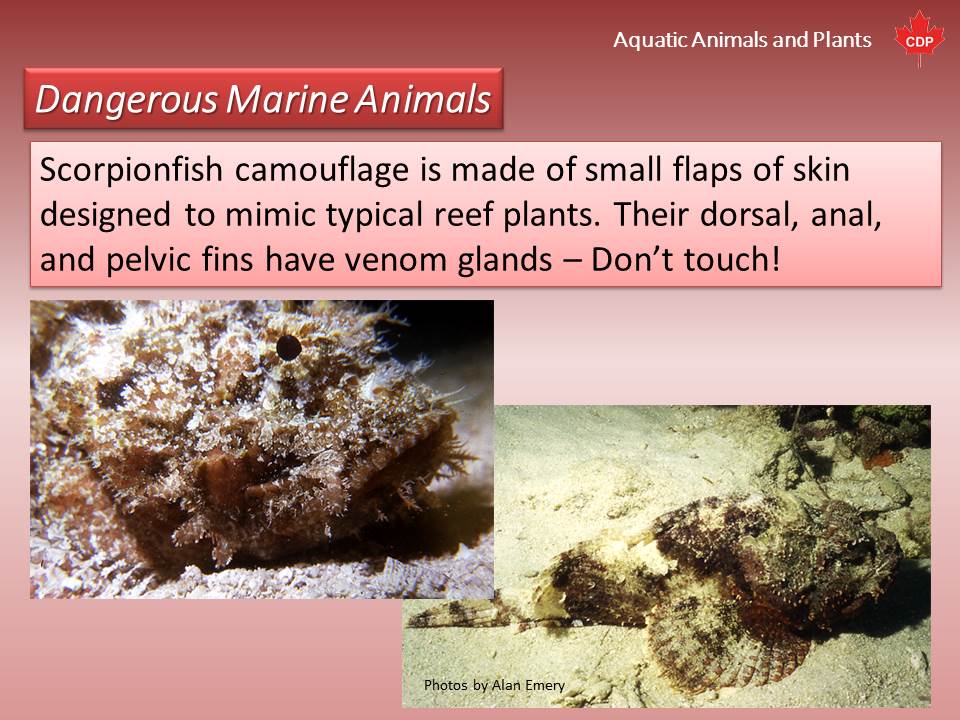
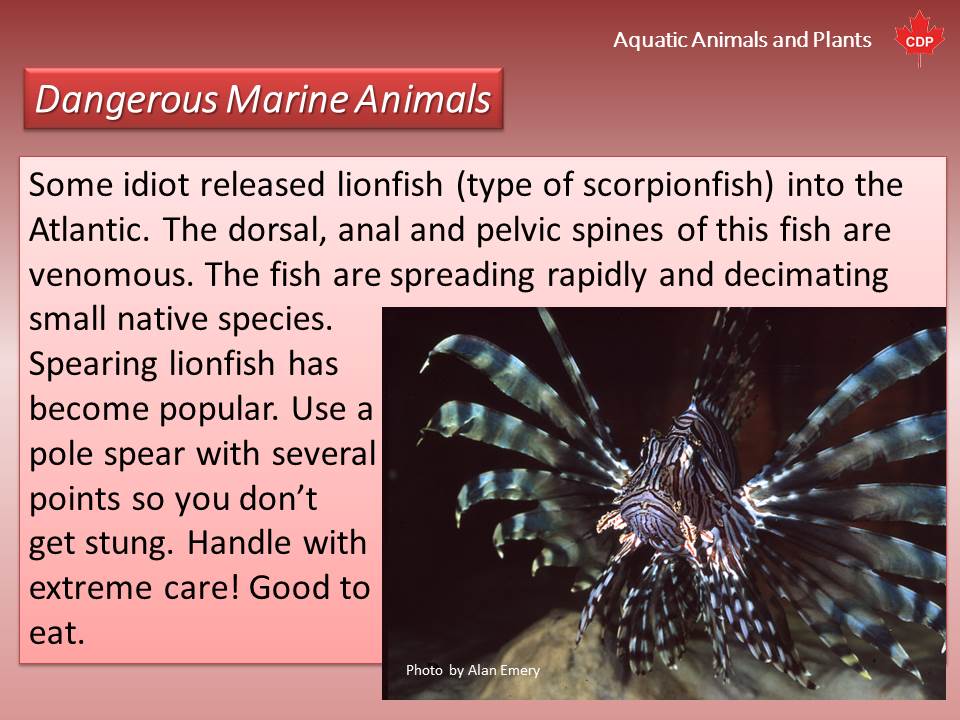
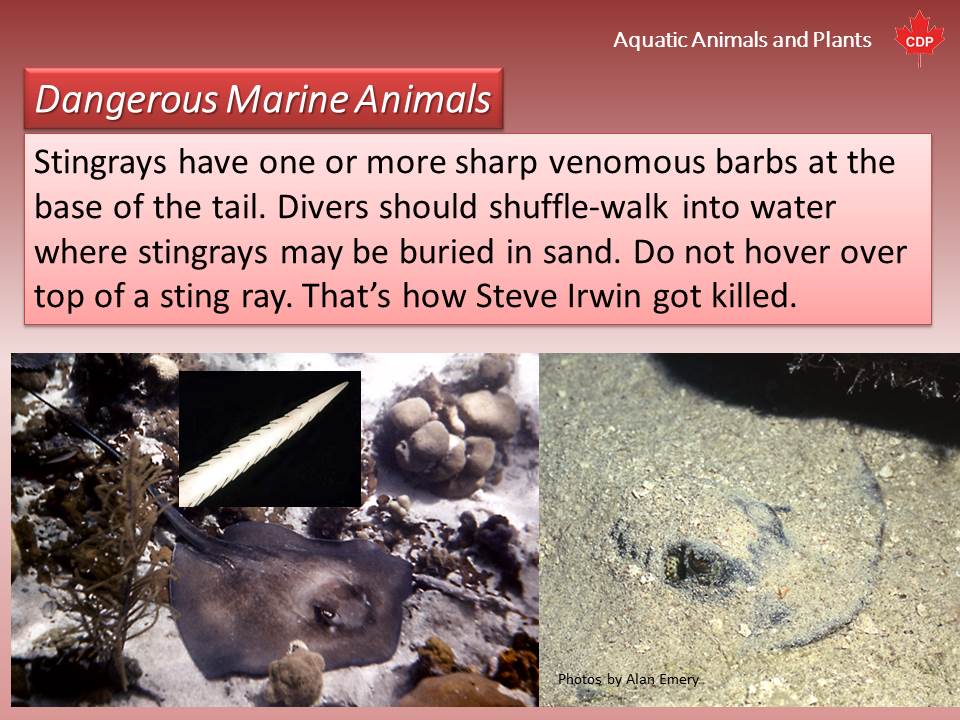
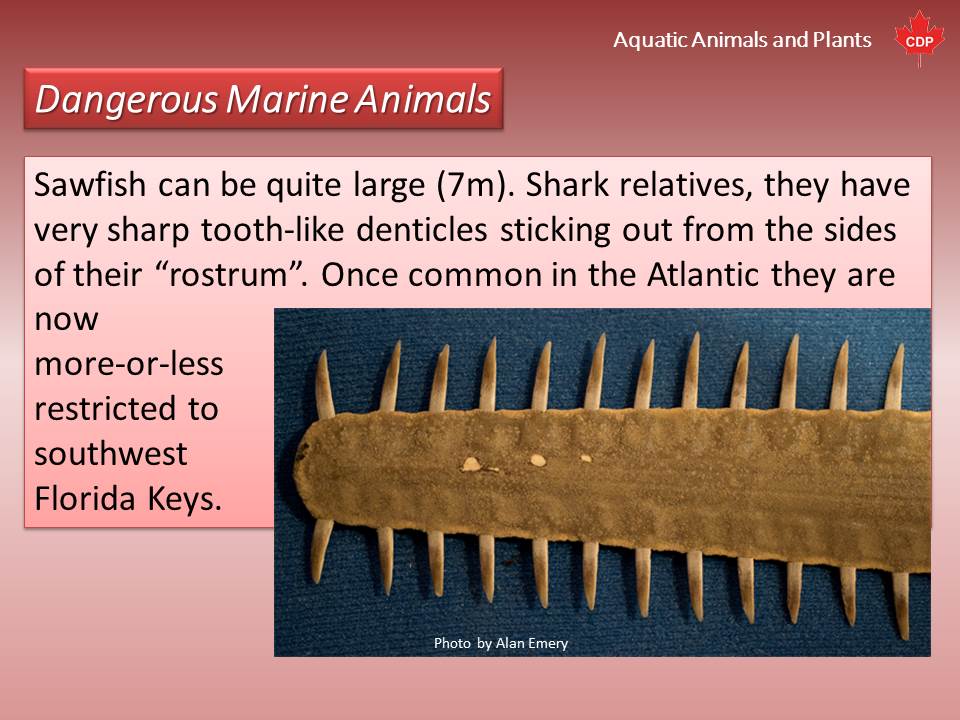
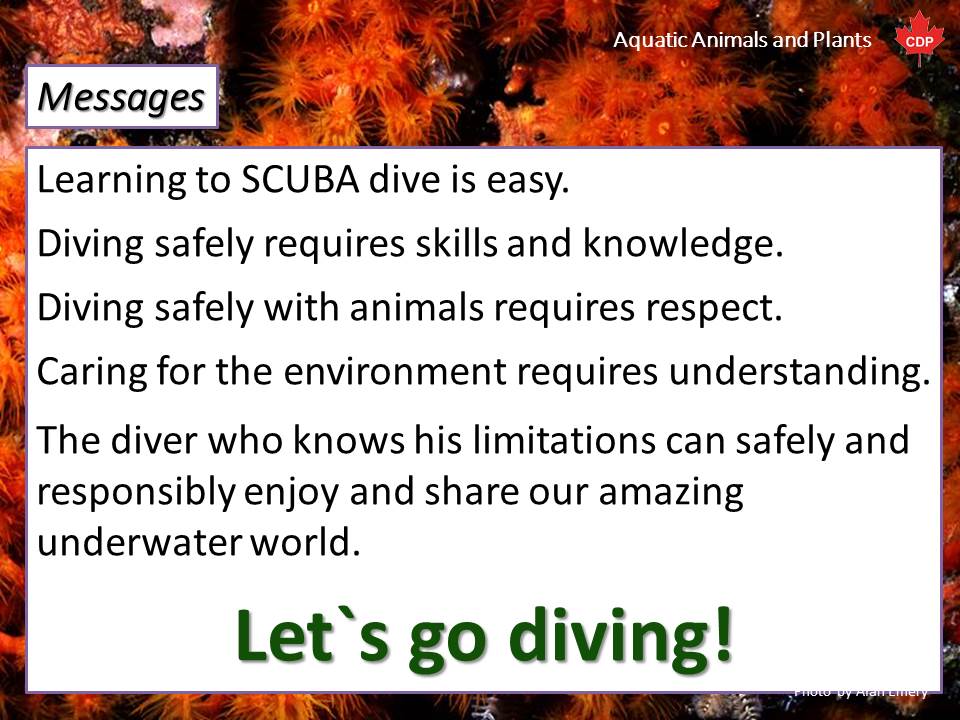
Thank you. This is very informative
Thanks….Its so informative … Learned a lot. . .
Wow aquatic life is very amazing. Thanks is very educative and informative too.